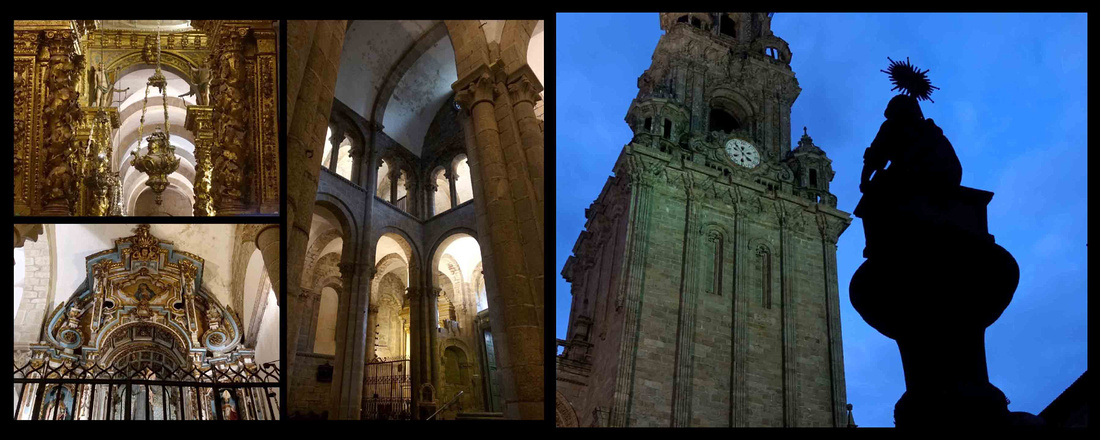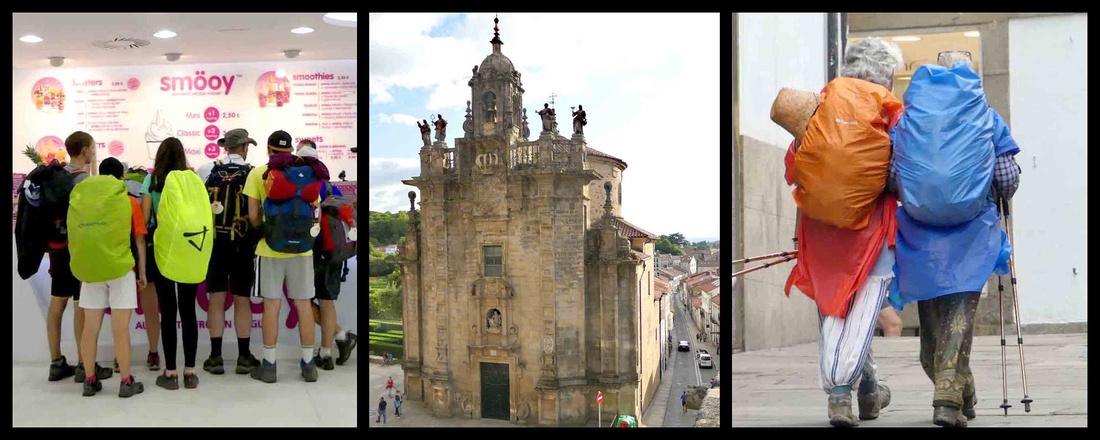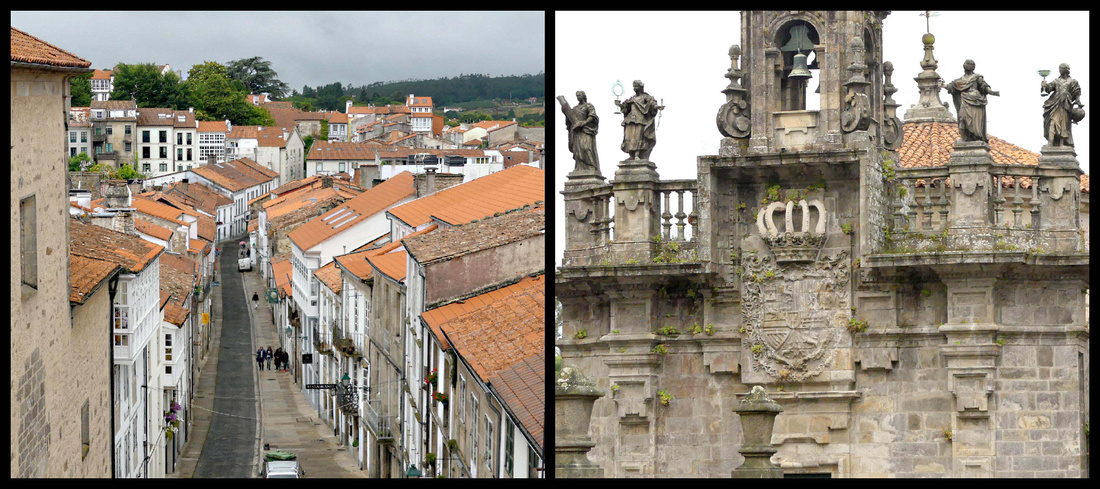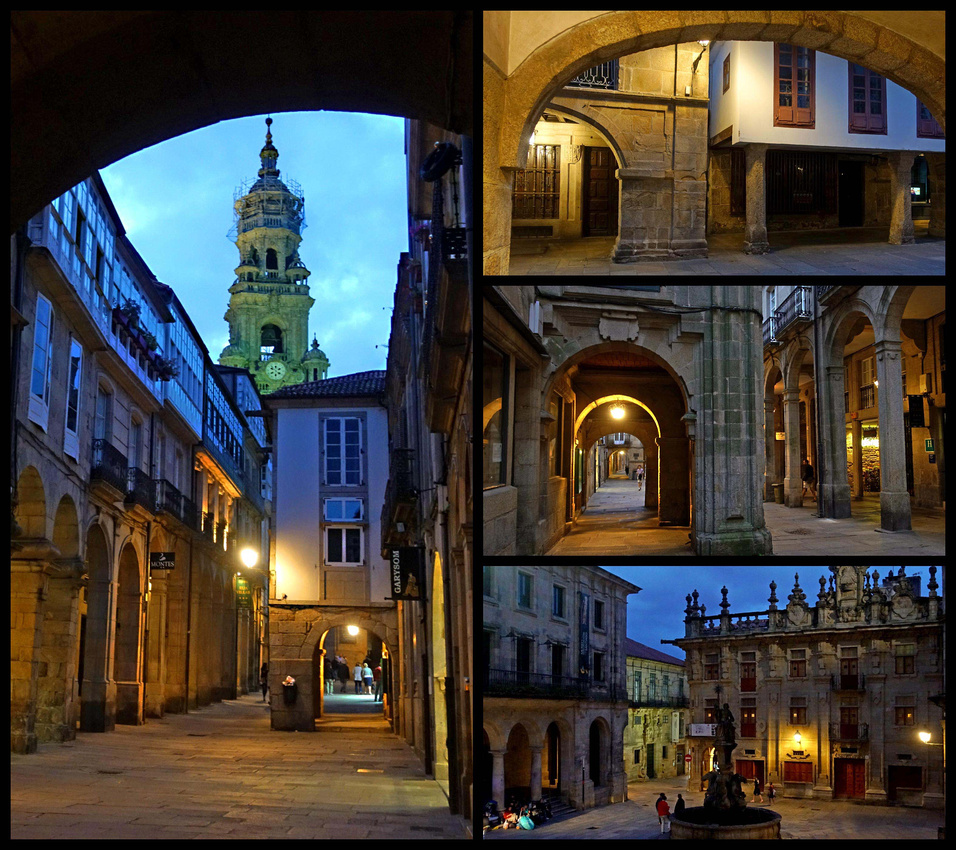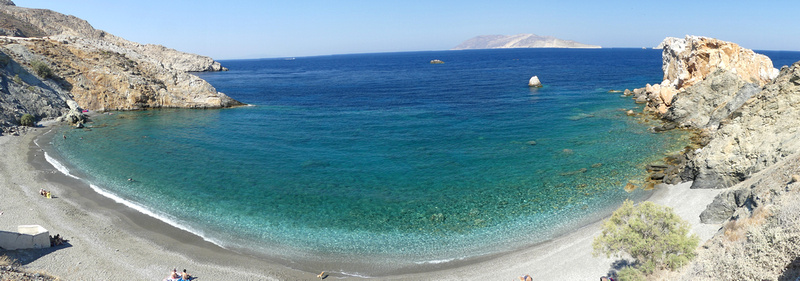


Crisscrossing the Camino: 5 weeks in Northern Spain Part 4 - Burgos to Santiago
BURGOS Camino Frances
After Santander I "crisscrossed" the Camino and took a bus from the Camino del Norte to the Camino Frances, to Burgos. Burgos felt very much like a “Spanish” city, not that the others weren’t, (well Bilbao and San Sebastian/Donista are Basque). The blindingly bright sunshine and hot weather helped.
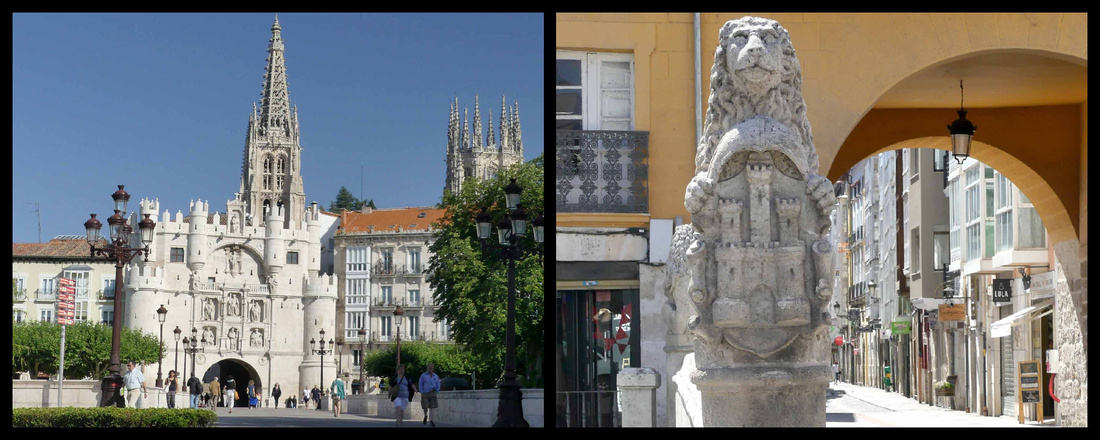

Founded in 884 as a fortification against Islamic invaders, the city, which was the capital of the unified kingdom of Castilla-Leon for five centuries, sits in the middle of Spain’s high plains, a cross-roads for a thousand years. Several centuries of decline culminated with the Napoleonic Wars destroying the castle and much of the city. Today, Burgos, population, 175,000, feels small and friendly, you can walk across the historic center in less than an hour. A candidate in 2016 for ‘European City of Culture’ (lost out to San Sebastian) it was spruced up and now the entire center is sparkling. While the kingdom of Castilla-Leon is now part of Spain, Burgos is the provincial capital and symbols of ‘castles and lions’ are everywhere. The main Camino de Santiago goes right through the center.
Rio Arlanzon delineates the historic center from the newer city. The river is quite small but there is an expanse of greenery on both banks that makes it a rather pastoral setting for the center of a city. The Paseo del Espolon is a wide, plane tree shaded promenade along the banks that feels much more like a park than a promenade. There are benches and fountains and in July there were little white tents housing an arts and crafts market in the evenings. Lining one side are cafes and restaurants.
The main pedestrian bridge, Puente de Santa Maria, leads to the Arco de Santa Maria – the first thing you see as you approach the center of Burgos is this grand arch – from a distance it blends in with the cathedral. Originally built in the 14th century as a triumphal arch in honor of Emperor Carlos V, it formed part of the 11th century city walls. It was turreted and decorated in the 16th century. In 1552, the gate was renovated in Renaissance style. The interior is not especially interesting though there is one large fresco. It houses temporary art exhibits.
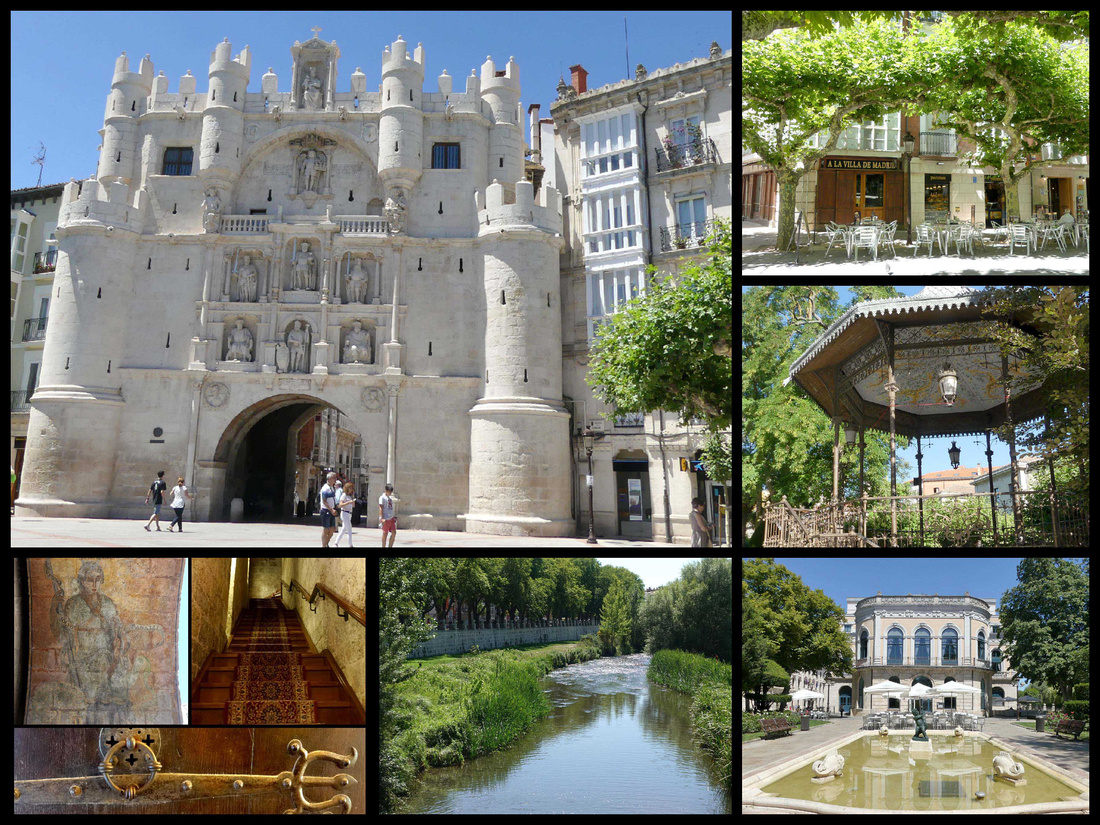

Through the arch is the large Plaza del Rey San Fernando and the cathedral. You can see the spires of the Cathedral from pretty much everywhere within the town. It’s just gorgeous and massive in both bulk and height. It’s setting is also impressive with a small square, Plaza de Santa Maria, in front of it, with a fountain and steps going up along the side of the square so you are looking straight at the cathedral, rather than just up at it.
At the top of the steps of Plaza de Santa Maria, just behind the cathedral is the Iglesia de San Nicolas, a smaller church that also blends with the overall appearance of the cathedral though it is clearly a separate church. The street in front of San Nicolas, along the north side of the cathedral is the Camino. Burgos was historically one of the most important cities on the Camino and at one time had over 30 ‘hospitals’ dedicated to the pilgrims. (‘Hospitals housed pilgrims, some of which are still albergues, or hostels).




top: Plaza de Santa Maria bottom left: Plaza del Rey San Feranando center: Cathedral right: fountain in Plaza de Santa Maria
UNESCO-listed Cathedral of Burgos, a masterpiece of Gothic architecture, was begun in 1221 and is the third largest in Spain (after Seville and Toledo). The profusion of sculptural decoration and grandiose proportions make it one of the most impressive in Europe and one of the best examples of French Gothic. WOW – that really is a spectacular building. The size of the building is even more impressive from the inside than the outside. Built from white limestone, and predominantly Gothic, the building reveals other artistic styles that represent later additions (constructed from 1221 to 1795). The spires were only completed in the 19th century. The cathedral's main façade features the Puerta del Perdón doorway above which is a beautiful star-patterned rose window called an estrellón. Every side is just as beautiful as the last. And the cloisters, always my favorite part of any church, did not disappoint. There are two levels, and the upper level is glassed in with stained glass. A lot of the stone is painted which is unusual for most cloisters, which are just natural stone. The lower level is equally nice and the views of the towers and spires from the cloister are beautiful.
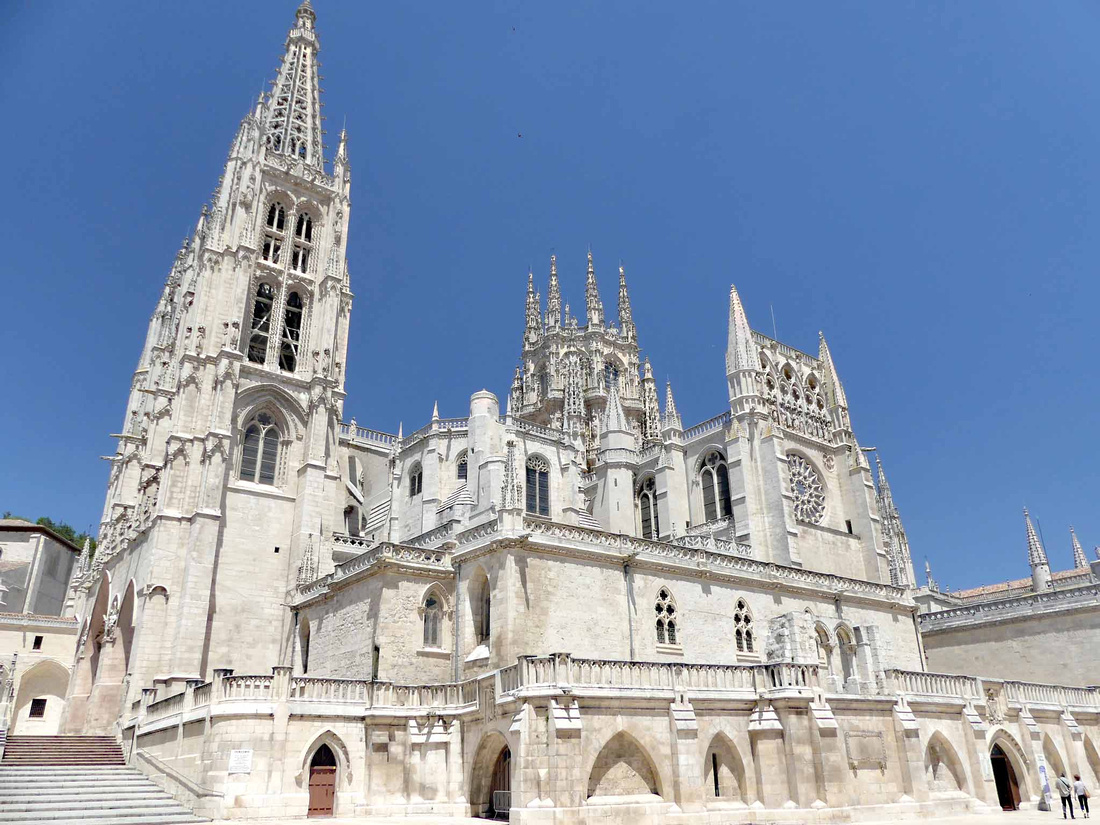

Just as amazing inside as out, extremely light and delicate and intricate. You can get a stiff neck looking up. It embodies Flamboyant Gothic style and is richly decorated with sculptured filigree everywhere. There are nineteen side chapels, each more highly decorated than the other, but most with a very light, airy feel unlike a lot of Catholic cathedrals which are dark and foreboding. This church is a riot of spiky spires and towers, pointy arches, four-leaf clovers, and flowery vaulted ceilings.


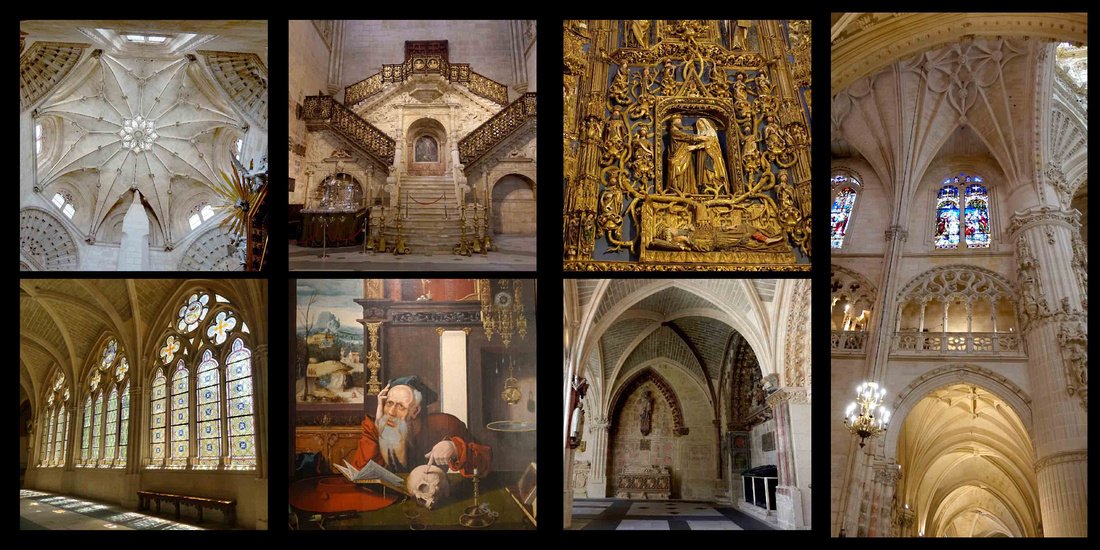



Top from steps in Plaza Santa Maria Bottom left: cathedral back from the Camino Bottom right: from the cloister
At the other end of the Paseo del Espolon is the Plaza de Mio Cid just over the river from the modern city. Puente de San Pablo is lined with sculptures of characters related to El Cid. The Plaza features a statue of El Cid, Estatua del Cid, the city’s hero (and pronounced El Thid, in pure Castilian Spanish) (he pursued a campaign against the Muslims in the 11th century). The Teatro Principal and Provincial Palace line the plaza and it is the starting point for Calle Vitoria and Calle Santander, two of the city’s main streets. Just down Calle Santander is Casa de los Condestables/Casa del Cordon, with a massive corded façade and two towers, 15th century. It was here that the Catholic Monarchs received Columbus after he returned from his second voyage. Across Puente de San Pablo in the modern citiy is Museo de la Evolucion Humana.


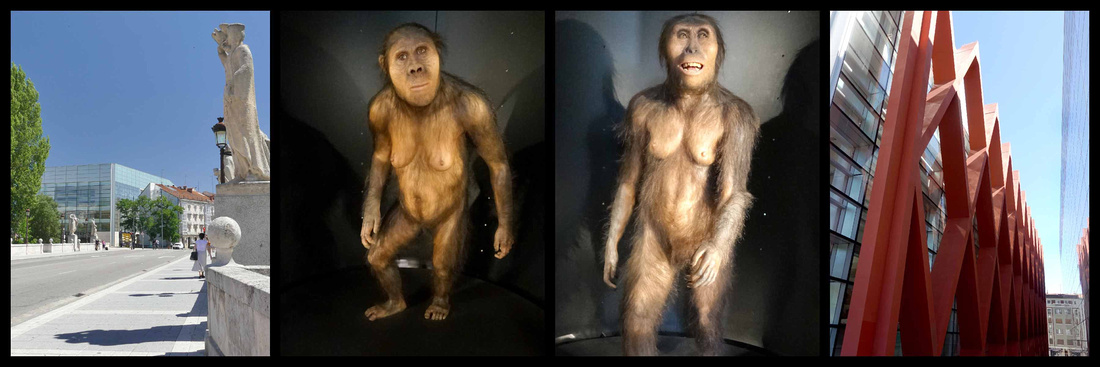

Plaza Mayor is in the historic center, home to the Ayuntamiento, in neoclassical style from the 18th century. The center of the square is full of modern benches, but it is lined with shops and eateries and colorful buildings in the Burgos style with glass fronted balconies. The Casa Consistorial (Ayuntamiento) has marks and dates from two of Burgos’s biggest floods; it’s hard to believe that the friendly little river could ever make it that high.
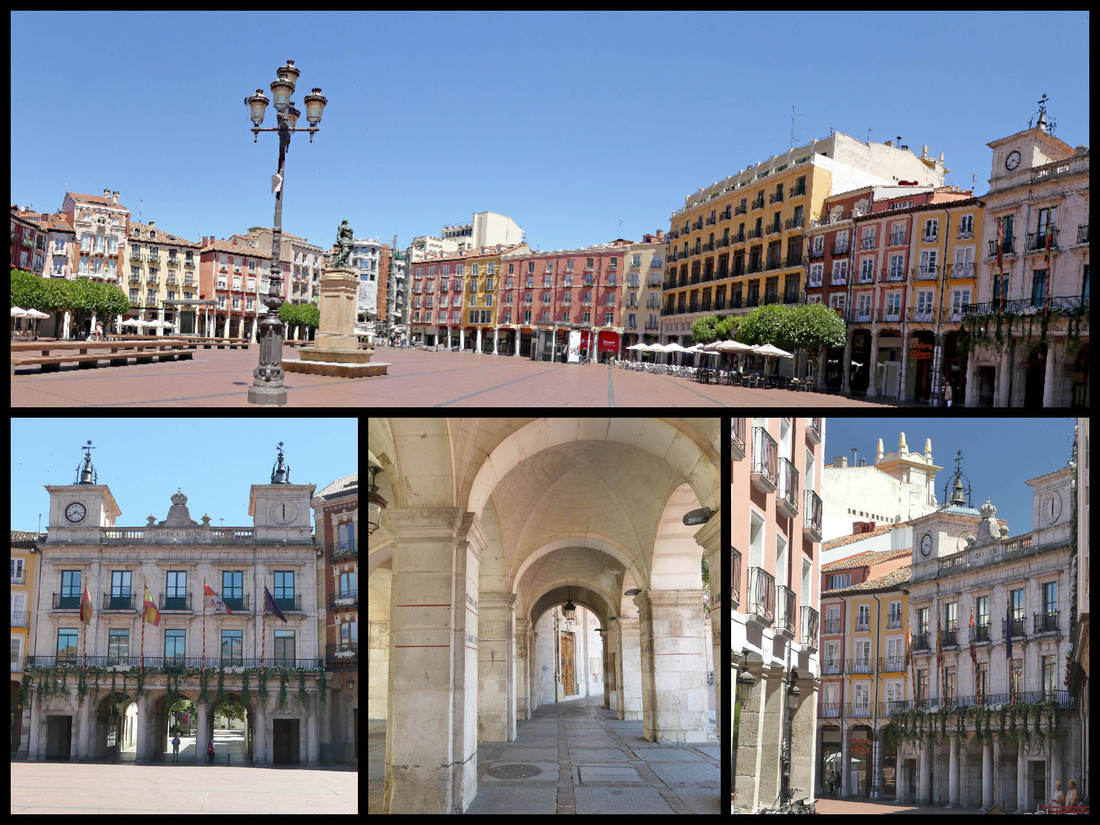

The old town feels much lighter and more airy than many old towns. The streets are wider and many of the buildings feature glassed balconies. One of the most beautiful buildings is Palacio de Capitania, early 20th century. Iglesia de San Lorenzo, buried deep in the medieval streets of the old town, is 17th century. Another feature of Burgos is bronze statues, featuring everyday people and found throughout the city.
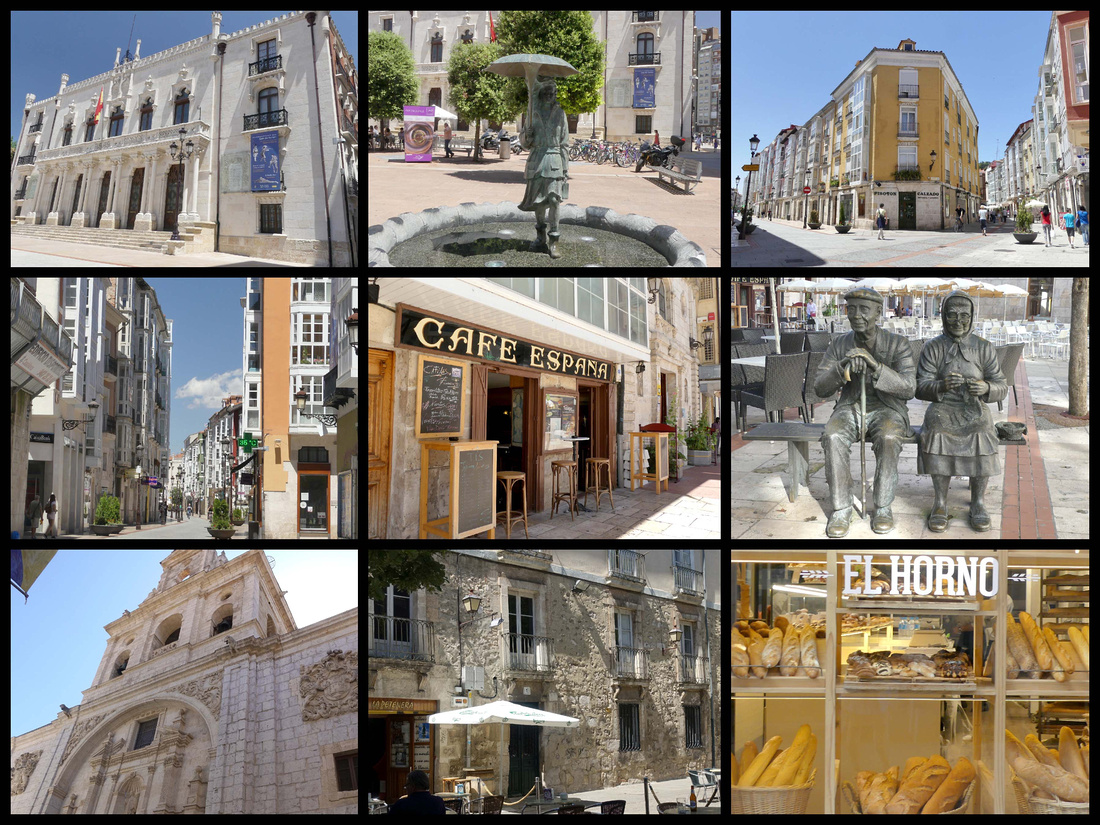

top left: Palacio de Capitania bottom left: San Lorenzo
The Camino enters Burgos center through the Arco de San Juan, follows Calle de San Juan to the church of San Gil, passes between the Church of San Nicholas and the Cathedral, then leaves the city through the Gate of San Martin. The Camino has played a significant role in the life of the city and was its cultural and economic communication road with Europe, influencing the urban layout of the city.
Iglesia de San Lesmes, 15th century, sits on the banks of the small River Vena just outside the Arco de San Juan.
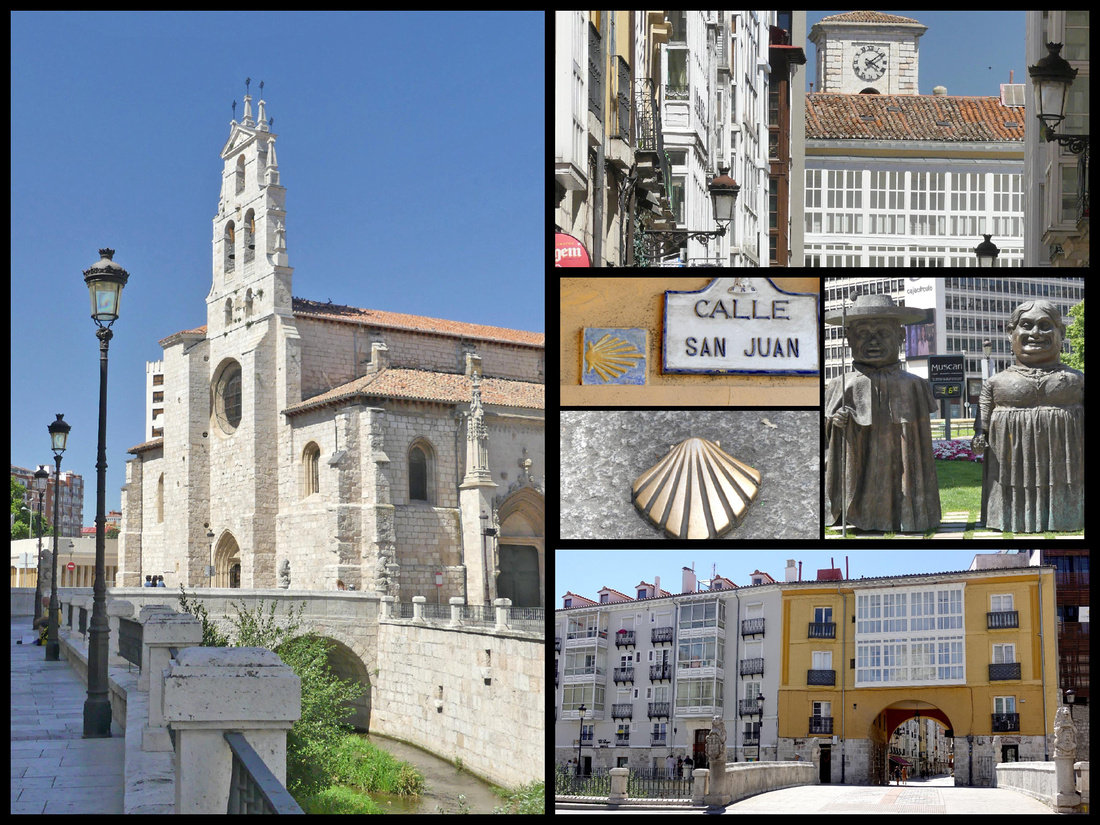

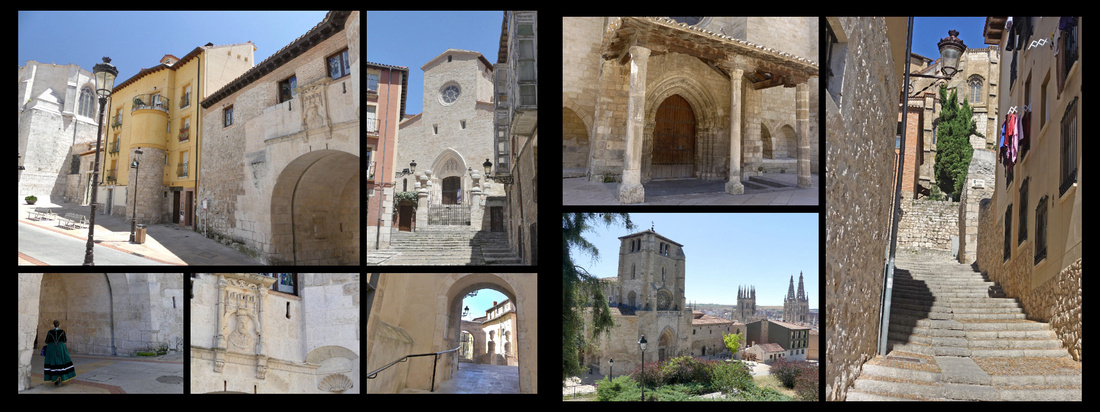

left: Iglesia and Arco de San Gil, 14th to 16th century, the church built right into the walls right: Iglesia de San Estaban, 13-14th century
Several sections of the town walls remain including those between Arco San Gil and the Castillo, and along side Arco de San Martin. The Castillo is where the original city was founded, today it is mostly a leafy park. Houses once covered the slopes of the hill down to the location of the Cathedral. Interesting displays in the cathedral show what the city looked like when the cathedral was being built. The Castle was destroyed by Napoleon in 1813 but some of the ramparts remain and there are displays showing what it used to look like. Views extend beyond the modern city of Burgos to the plains (and windmills) beyond.
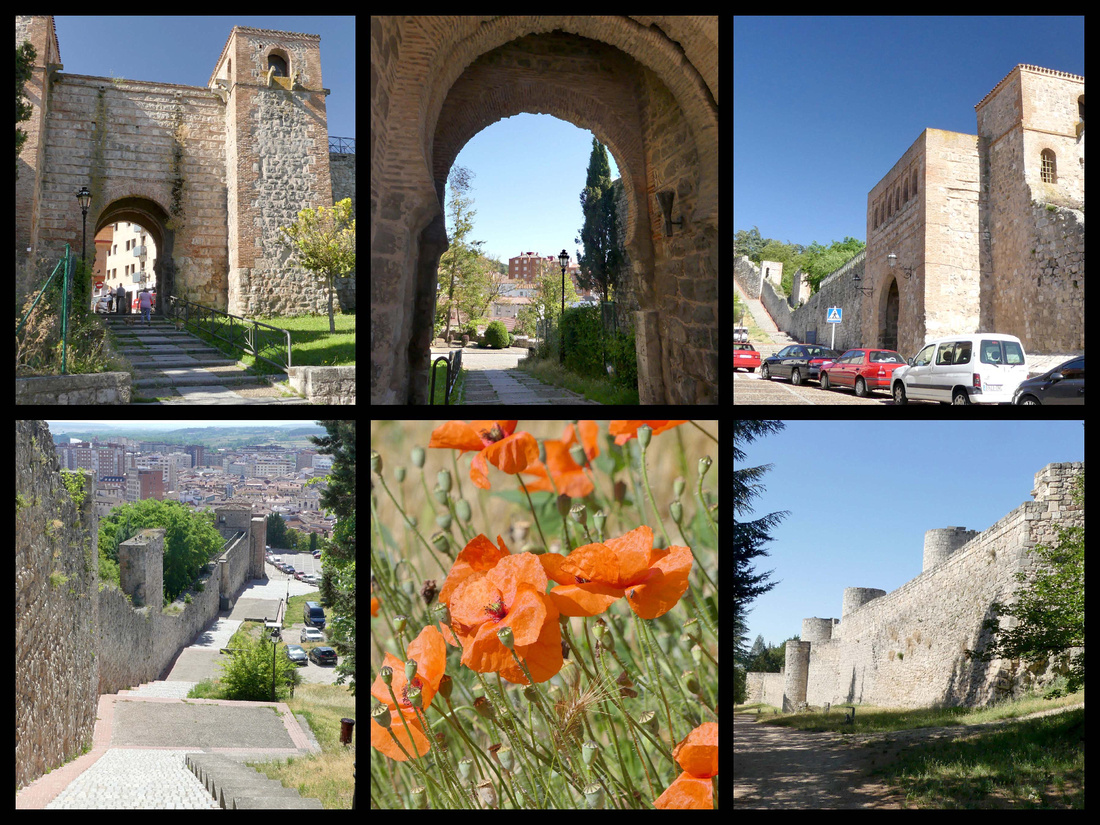

Arco de San Martin, a Muddejar style gate from the 14th century through which pilgrims leave the city, and which historically monarchs entered once the city’s privileges had been sworn. Several churches nearby had storks nests atop them.
Parque de la Isla, a park along the river laid out in the 19th century with a wide variety of trees and plants and various artistic elements such as the classical arches of the Palace of the Count of Castilfale, the Renaissance fountains from the Monastery of San Pedro de Arlanza and the Romanesque front of the church of Cerezo de Rio Tiron.
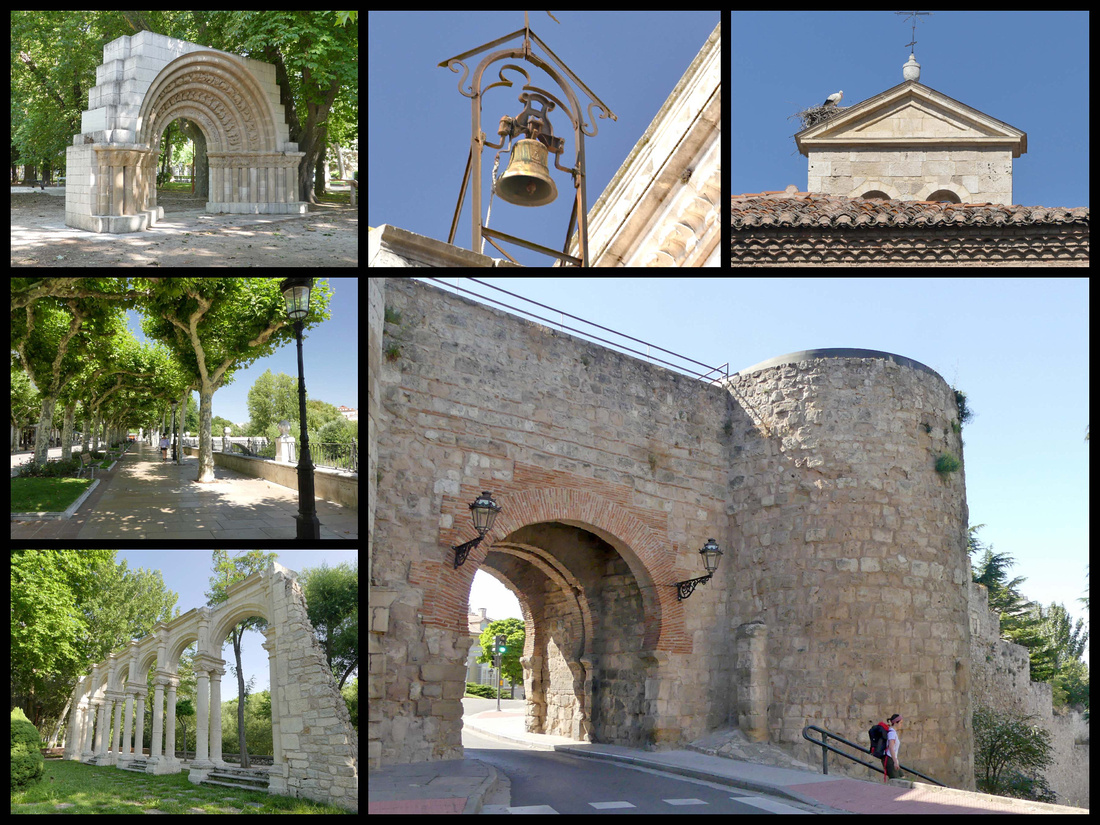

Monastererio de las Huelgas - a medieval Cistercian monastery which was originally a country residence of the kings of Castile is about a half hour walk from the center, through Parque de la Isla. The Spanish word huelga means "repose/relaxation." King Alfonso VIII converted the building into a convent for noble women in 1187. The monastery exemplifies the austere architecture of the Cistercian order, and includes the church, cloister, and chapter house. The original 12th century church was built with a Mudéjar Almohad style, resembling the architecture of Andalusia. It still houses about 40 cloistered nuns so can only be visited by guided tour (long, in Spanish only). To keep the nuns separate from the public, the church was partitioned in the 16th century, and the naves separated by walls. There's a moving pulpit that enabled the priest to address both the congregation and the separated nuns. There is a large cloister and a very pretty smaller cloister with amazing carved plasterwork, no doubt Moorish-influenced.
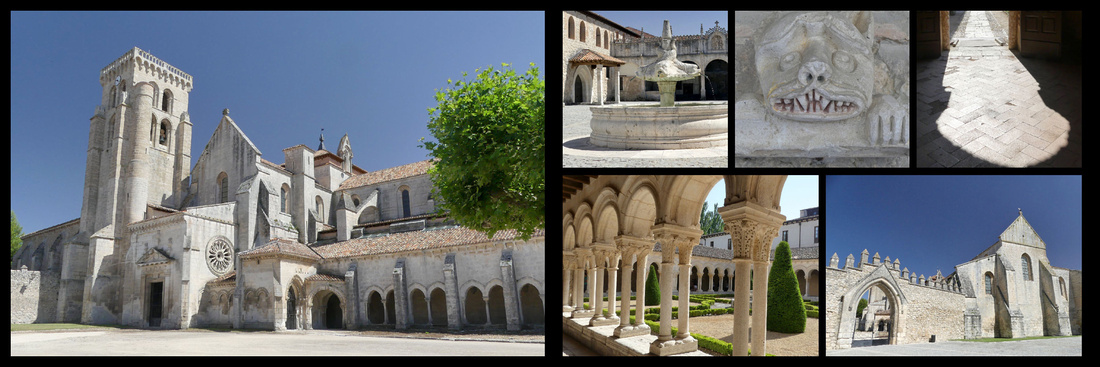





We took the bus from Burgos to Leon, a trip which is less than two hours via the highway but which most of the time followed the “N” road so took over three hours. Much of the time we were on the Camino and could see pilgrims walking alongside the road, sometimes right on it, usually in a dirt track just to the side. About half the people who got on the bus in Burgos were pilgrims and as the bus stopped numerous times more got on at each stop (only once did a few get off). Once the bus stopped and picked up a few pilgrims and then, as it was pulling away we saw several more waiting (in the shade) on the other side of the road, waving madly at the bus, which did not stop. Bummer, as there wasn’t another bus scheduled to do that route for several hours. So essentially you can cut out over a quarter of the total Camino by taking that bus ride. (183 km of the total 780 km) – or about 7-9 days of walking). The land is mostly flat and almost entirely golden wheat fields, with a few scattered fields of sunflowers, and a few decrepit little towns. Way off in the distance you can see the mountains of the Picos de Europa . It was kind of pretty to look at – for a few hours, no way would I want to walk for over a week of that same scenery. The bus station is in the newer part of Leon, just down the street from the train station (and car rental pick up location).


León Camino Frances
A concentration of beautiful architecture from varying periods, one of the premier stops on the Camino, a lively student population, a spectacular cathedral, a picturesque old quarter – the Barrio Humedo. Immediately loved Leon. From the bus and train stations just across the river (which has extensive riverside gardens) to the cathedral is about 1km. The old town lies immediately south of the cathedral.
Located at the base of the Cantabrian Mountains, and starting life as a provincial Roman settlement, Leon lived through Muslim invasions, entering it’s zenith in the Middle Ages. It was the capital of one of the major regions in the Christian re-conquest of Spain. In the 10th century Leon was a model of reasonable, civilized medieval government. León today is the gateway from Old Castile to the northwestern region. There were signs celebrating that 2017 was the 1000th anniversary of León, which was really interesting to us as our town in Massachusetts just had a huge celebration for it’s “250th” old in North American terms but Leon is four times that old.
It’s a little-known fact that the Spanish city of León’s name only coincidentally means “lion” in modern Spanish. It was founded as an encampment for Roman legions, the Latin name for this legionary town (Legio) converged with the word for lion (leo) over the centuries as Latin grew into Spanish. Apparently this distinction was also lost on the locals and a lion is now the city’s symbol. All over Leon are lions - freestanding sculptures, imbedded on facades, on the manhole covers, on flags, etc. In Burgos, which is in ‘Castile y Leon’ there are lions along with castles featured everywhere.
Puente de los Leones – From the newer part of town where the bus and train stations are located cross this bridge with large Lion sculptures at all four corners, over the Bernesga River to the first main plaza, Plaza Guzman Bueno, a busy traffic circle but it has a beautiful huge fountain in the center and is surrounded by nice buildings. The main street leading into the old town is Ave Ordono II which leads to
Plaza de Santo Domingo – the next main plaza, a somewhat smaller traffic circle but also with nice fountain in the middle and surrounded by attractive buildings. This is the start of the old town, the street name changes to Calle Ancha and it becomes pedestrianized. You immediately see two of the most gorgeous buildings in Leon, Palacio delos Guzmanes and Casa de Botines.
Plaza San Marcelo - Plaza San Marcelo is adjacent to the larger Plaza de Santo Domingo. Iglesia de San Marcelo. Built between 1588 and 1627. Home to the Ayuntamiento which occupies a Renaissance era palace.
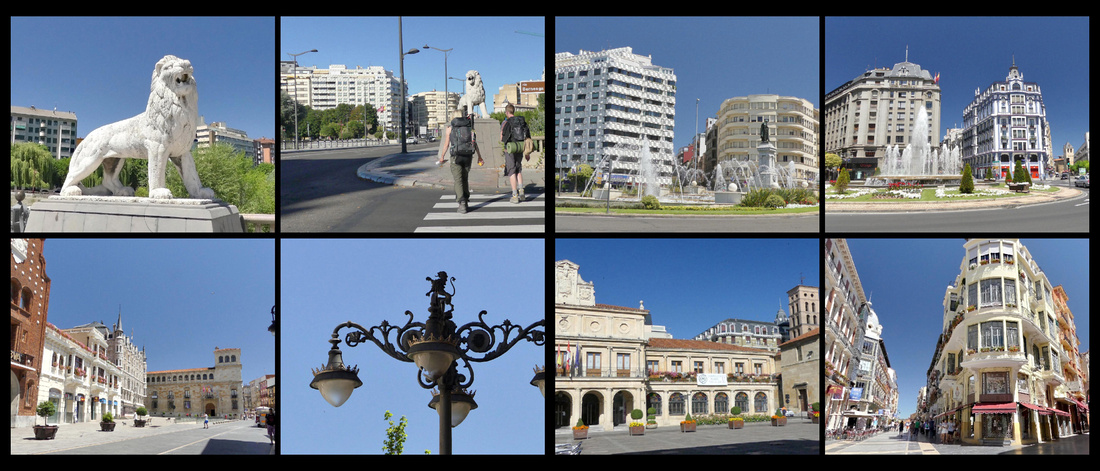

Palacio de los Guzmanes is an impressive 16th century Renaissance palace designed in the style of an Italian palazzo. It has an imposing facade with rounded arches, large corner towers, and wrought-iron balconies. Once a private residence, the palace is designed around a courtyard featuring classical columns. The palace currently houses the Leon Regional Government.
Next door is Gaudi’s castle like neo-gothic Casa de Botines (1893), with stained-glass windows and sharply pointed turreted towers. Gaudí started the project in 1891 when it was commissioned by textile merchants of León. Business was conducted on the ground floors, and the upper floors were designed as private apartments. The building’s façade features St George sticking it to a dragon; a bronze sculpture of Gaudí observes his creation from a park bench outside.
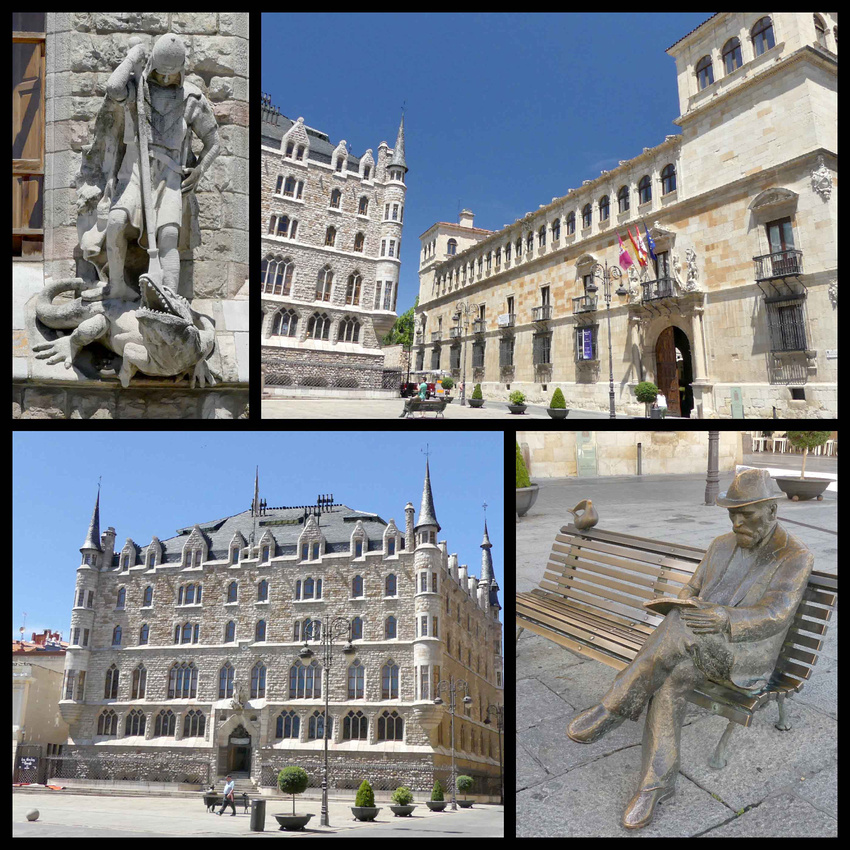



León Cathedral, a UNESCO site, is surprisingly French in style. A huge rose window dominates the west façade, and there is literally wall-to-wall stained glass that covers the entire upper half of the church. Massive panes span from the pointed arches up to the ceiling, giving the impression that the walls simply vanish into glorious light. The whole atmosphere is truly dazzling. The windows transform the usual gloomy gray stone interior into a reddish-purplish wonderland, though it is still quite dark inside. This only enhanced the beauty of the stained glass. There is a €6 fee to visit the church (includes an audio guide) and a separate €2 to visit the cloisters which are entered from the side.
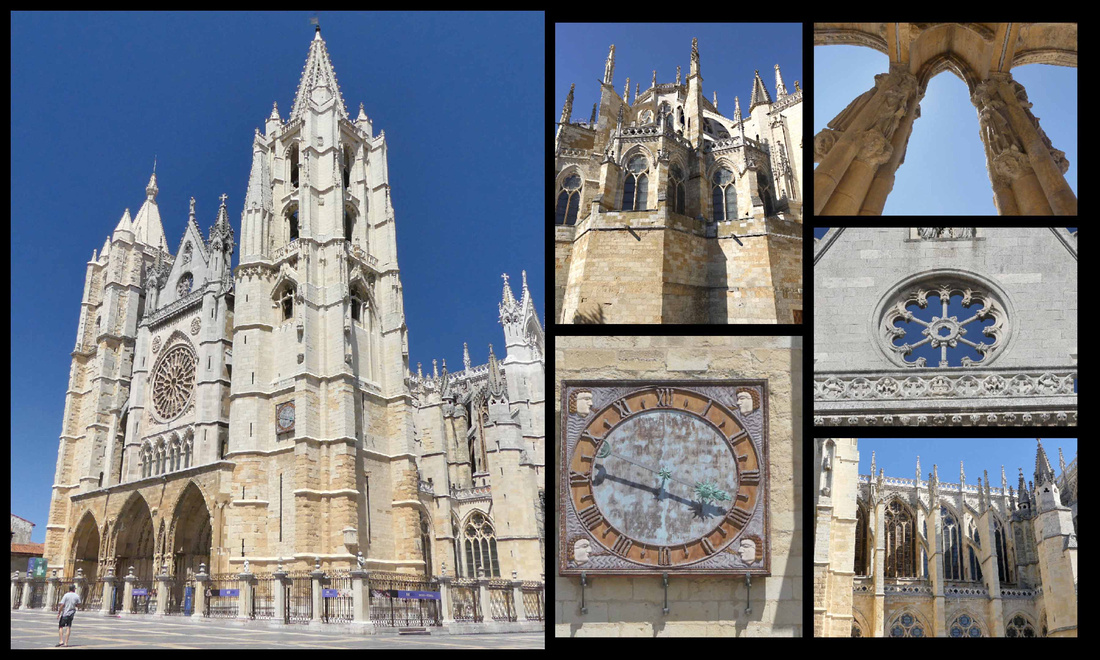

It was begun in 1258 in the Romanesque style, but the soaring upper portions are Gothic at its best. It took 200 years to build, though the upper portion only about 50 years, in the 1300s. The exterior is covered in towers and flying buttresses which range in size and shape. Symmetry was certainly not the goal of this cathedral. In the church-building frenzy of the Middle Ages, every Gothic cathedral vied to distinguish itself with some superlative trait. Milan Cathedral was the biggest, Chartres had the most inspiring stained-glass windows, Palma de Majorca had the largest rose window, and so on. Structurally, though, the boldest cathedral was León. It set the record for the highest proportion of window space, with stained-glass windows soaring 34m to the vaulted ceiling, framed by the slenderest of columns. The windows occupy almost all the space where you'd expect the walls to be. The peaceful, light filled claustro (cloister) has 15th century frescoes. The main door has a triple-arched façade, expressively carved. The central portal features a jovial Christ above a graphic Hell, with demons cheerfully stuffing sinners into cooking pots.
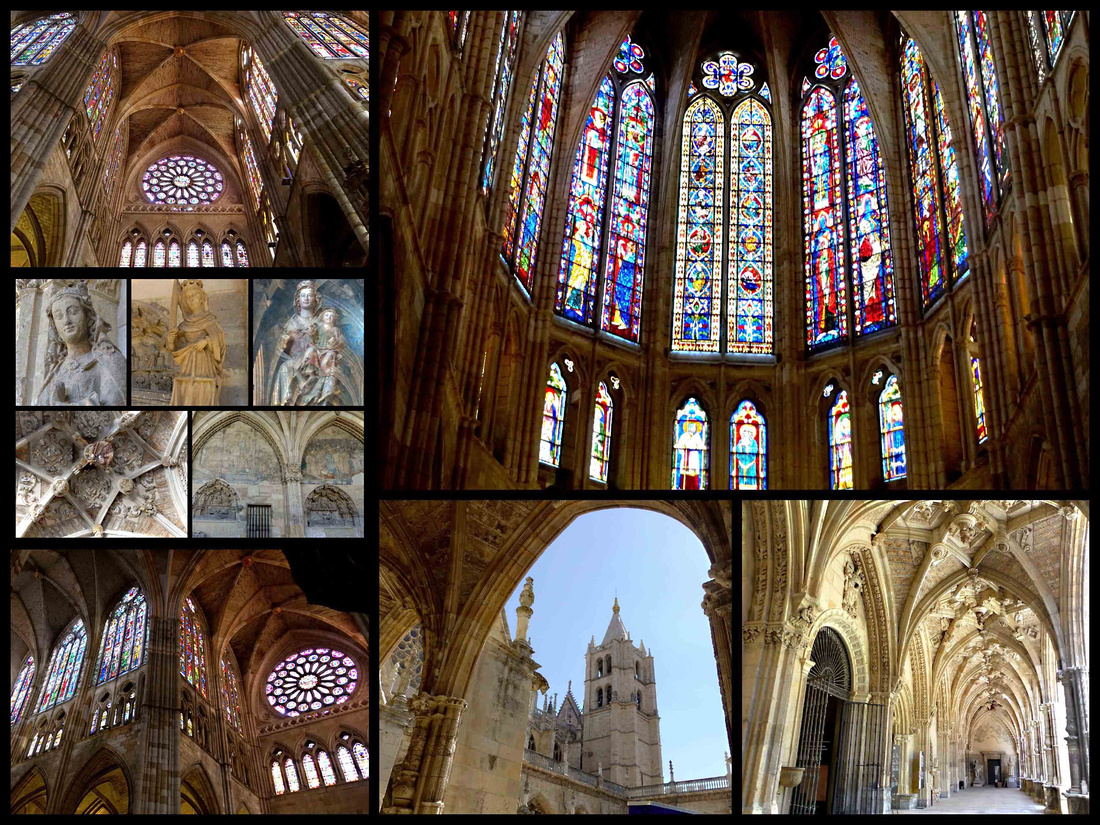

Plaza Regina - The medium size plaza in front of the cathedral has a nice building to the right, the Museo Diocesano de Arte Sacro, and a few souvenir shops and cafes/ice cream parlors opposite but is otherwise rather plain.
Plaza San Martin - At the heart of the Casco Antiguo (Old Town). This quaint public square is lined with bars and restaurants. This is ‘tapas and dinner’ central. From the Plaza de San Martín, many little streets wind their way around the medieval maze of the Old Town, most also filled with tapas bars.
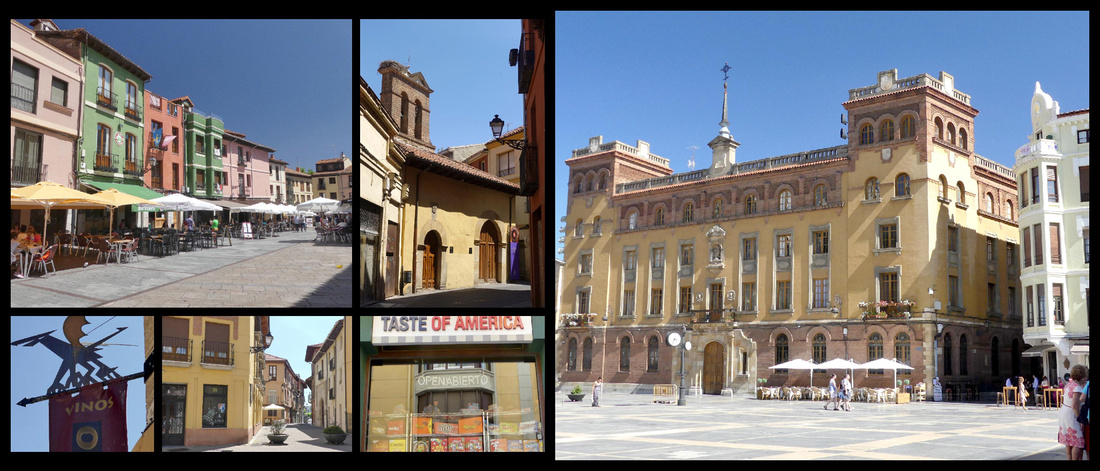

Plaza Mayor, beautiful and time worn, 17th century, sealed off on three sides by porticoes, this is a sleepy plaza by day, more lively in the evening with numerous tapas bars and restaurants. The old city centers around here, winding cobbled streets full of houses with wrought-iron balconies. Ayuntamiento antigo is the old town hall.


Plaza de Santa Maria del Camino (aka Plaza del Grano, for its one-time wheat exchange) feels like a cobblestone Castilian village square and is overlooked by Romanesque Iglesia de Santa Maria del Mercado. It’s a lovely time-worn space with rough cobbles, wooden arcades and a pretty Romanesque church. In the morning it’s largely shaded and had several locals and their dogs hanging out. Later in the day it’s hot and sunny and the families and dogs are replaced with people having drinks at the café under umbrella shade.
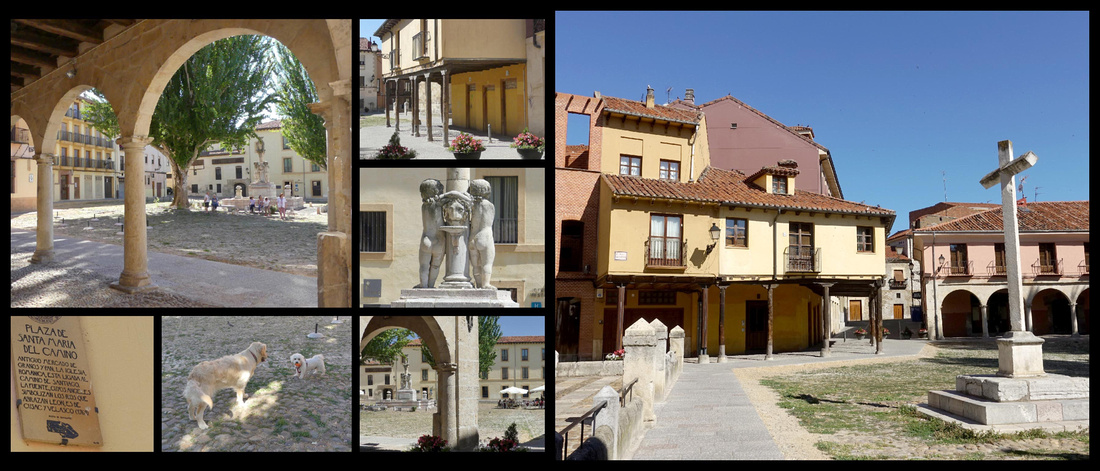

San Isidoro - one of the oldest Romanesque churches in Spain. Although it’s been spruced up over the centuries—the east section was rebuilt in Late Gothic style—the church looks generally as it would have a thousand years ago. On the south façade, are two Romanesque tympanums (the sculptures in the round semicircle above the doors), and within are some unique arches that look like they belong more in Moorish Andalucía than in northern Spain. The Puerta del Cordero (Doorway of the Lamb); the main doorway with sculptured figures of Saint Isidore, and the Lamb of God; and the Puerta del Perdón (door of forgiveness); pilgrims could gain absolution by passing through here if they were too infirm to continue their journey to Santiago.
The original 10th century church was built in the pre-Romanesque style of Asturias, similar to the ancient buildings in Oviedo. This early church was destroyed in 988 by Al-Mansur and later renovated by Christians in the 11th and 12th centuries in classic Romanesque style although the apses were converted to Gothic style.
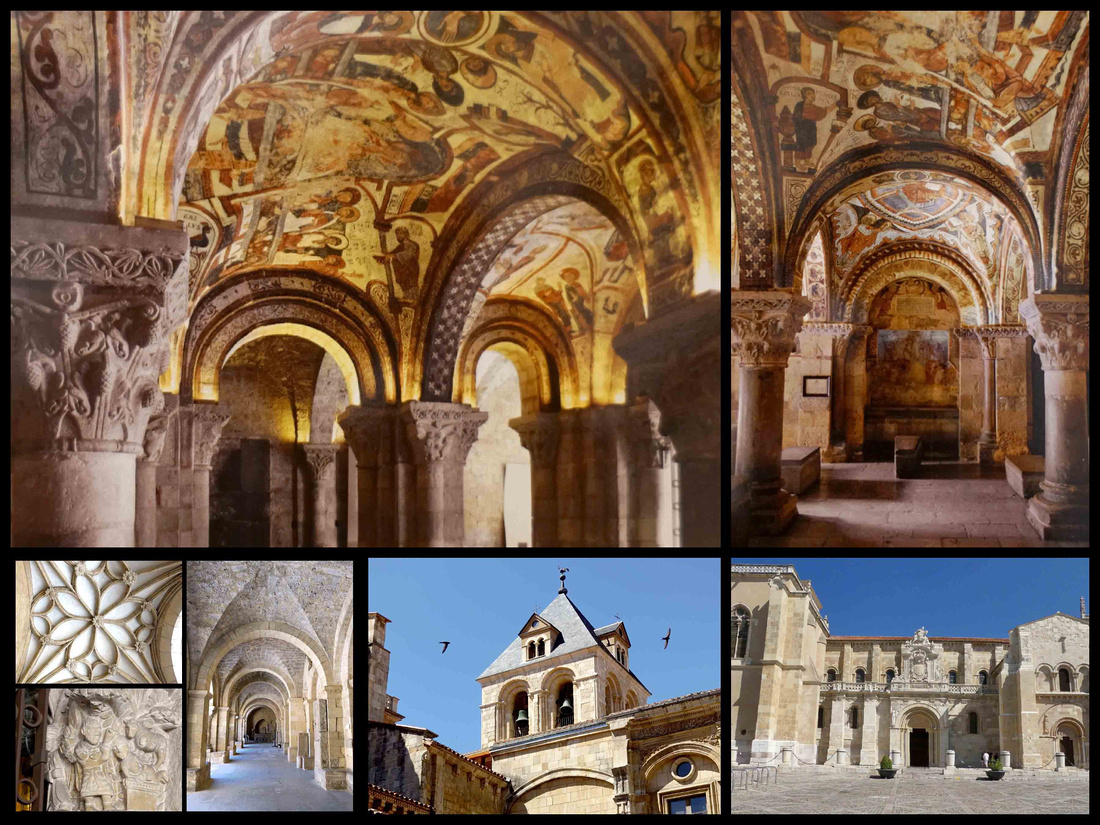

The highlight of visiting San Isidoro is the Panteón de los Reyes, the royal burial place for dozens of kings and queens who ruled the medieval Kingdom of León. Covering the entire ceiling are bright, thousand-year-old frescoes that represent biblical scenes, hunting scenes and an illustrated agricultural calendar interwoven with animal and plant designs. These vibrant, masterful paintings have earned the Pantheon the distinction of being compared to the "Sistine Chapel". They are in a superb state of preservation (never restoration, only ‘cleaned’ twice). You have to go on a tour to see it, and no photos are allowed – two things which are usually total turn offs for me but this tour was in English (cute Spanish guy who kept apologizing for his poor English but it was really quite fine and he was very interesting). Had to make do with postcards for pictures. The tour also included the cloisters (where photos were allowed) which was pretty good, and several rooms of artifacts. The top of the tower of the building has a ‘Cock’/rooster weather-vane, the original is in the museum and he explained that roosters were a symbol of the Muslims and this one was made in the 6th century and brought over from Persia by them when they occupied Spain. All in all worth the 5€ admission.
The complex is built into the medieval city walls, much of which is preserved.


San Marcos / Parador – At the edge of town on the Rio Bernesga, now a five star Parador, built in 1168 as a hospital for pilgrims on the road to Santiago. The ornate Plateresque façade was added in 1513 and is more than 100 m long. The exterior is Plateresque style, which means the intricate stonework, shells, and sculptures on the façade look like they were forged by silversmiths, or plateros in Spanish. This architectural movement was unique to Spain and was kind of a transition style between Gothic and Renaissance. A perhaps morbid factoid about this building: during the Spanish Civil War, it served as a concentration camp for Franco’s Nationalists. The church, museum and cloisters are quite extensive and are open for free.


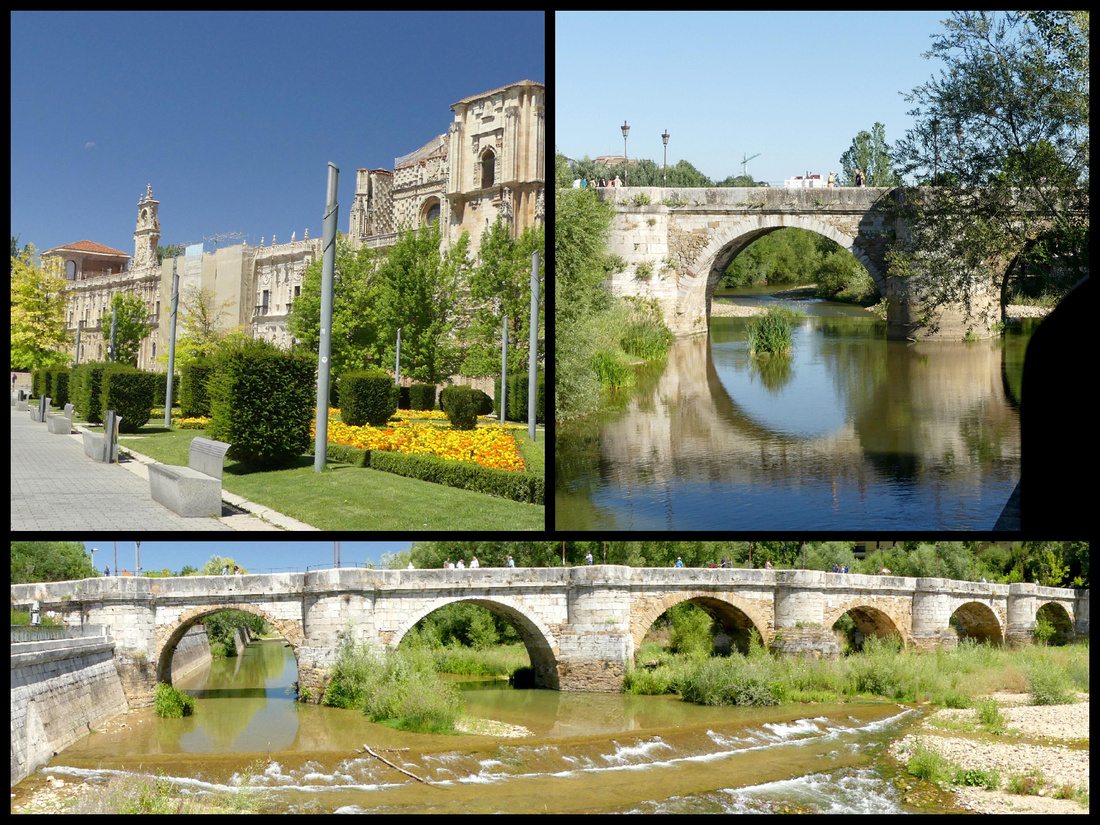

Right next to the parador/San Marcos is the Roman Bridge / Puente de San Marcos, a six arched stone bridge over the Rio Bernesga. The river itself is not very wide (at least in July) but it’s banks are, and they merge into a nice park which runs from the Roman Bridge to the Puente de los Leones.
We had considered staying at the Parador, I kind of wanted to do at least one Parador stay this trip, but in the case of Leon (and it turned out, several other locations as well including Ribadeo, Santillana and Olite) I found what I think were just as nice hotels for less money. Hotel Via Leon is right in the center of Leon, one block off Calle Ancha, less than a five minute walk from the cathedral and Plaza San Martin.
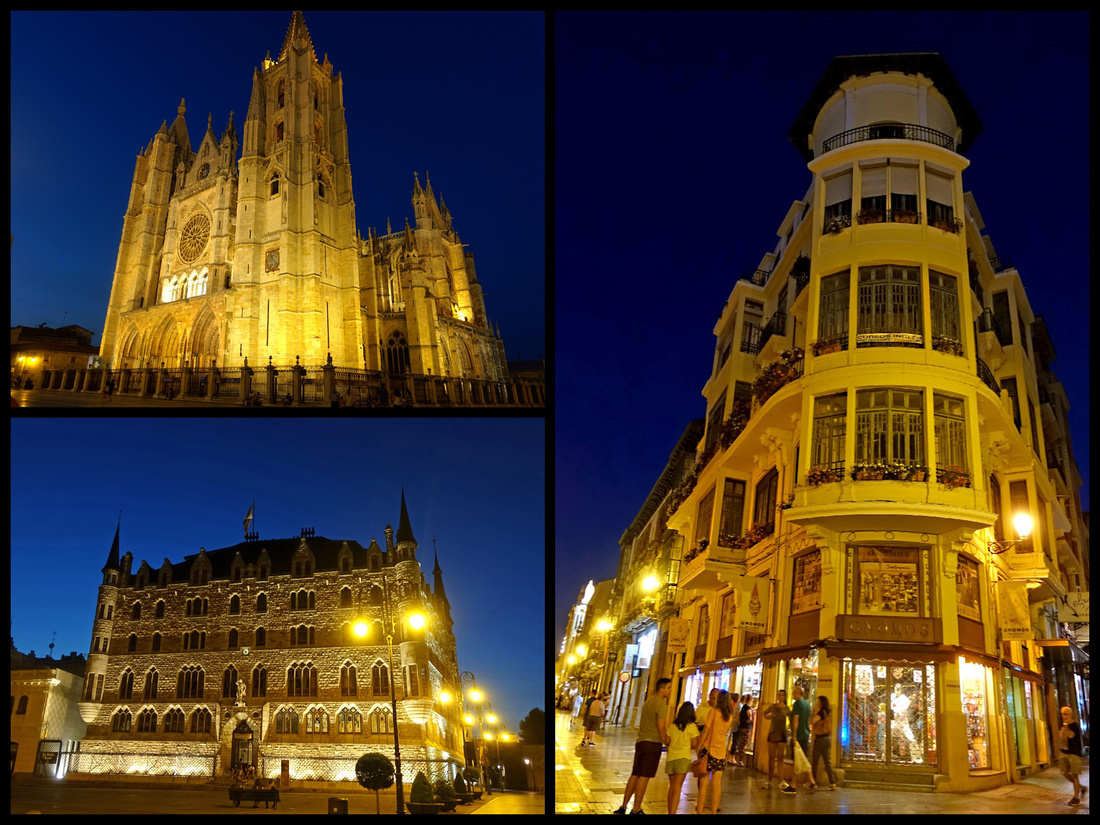

After two nights (one and a half days) – which was just about a perfect amount of time to explore Leon – we picked up our Fiat 500 and found our way out of Leon by following signs for Astorga. Numerous turns and round-a-bouts (all well marked) later we were on the highway for the 45 minute drive to Astorga. We had intended to get a SIM card for the iPhone so we could use google maps but the Vodaphone store was closed and we didn’t want to wait around an hour so we figured we’d get one later. Turned out driving that day was so easy we didn’t bother.
Astorga Camino Frances
On the frontier between the tan plains of northern Castilla and the green mountains of Galicia, Astorga, population 12,000) is a little town with attractions out of proportion to its size. In addition to its cathedral there is a Gaudi designed palace, and a smattering of Roman ruins and a couple nice sections of city wall. Astorgas’s old center is small and easily navigated (both in car and on foot). The cathedral and Palacio Episcopal are side by side in the northwestern corner of the old town.
We missed the turn into the first parking lot you come to off the main road and thus ended up driving through the center, which turned out to be a piece of cake (at this point I was thankful we weren’t in Italy cause it would probably have been a ZTL). We parked right in front of the Cathedral and I walked the half block to the parking ticket dispenser machine – and not only knew how to use it (we have the exact same machine at home) but showed a Spanish woman how it worked. I bought two hours worth of time, which was more than enough since it was too early in the day to be having lunch.
While Astorga has an interesting history, nothing much goes on there now. However, it’s a very pleasant, relaxed place with some attractive buildings and a peaceful small-town atmosphere. As a major Roman center for administering the gold-mining region further to the west, Astorga was known as Asturica Augusta, having been founded by Augustus during his campaigns against the never-say-die tribes of the northwest of the peninsula. The city is a key point in the Camino de Santiago, as two mains routes to Santiago, the French Way and the Vía de la Plata, meet there and there was an abundance of blue and yellow scallop shell signs and yellow arrows.
The Catedral has a Plateresque southern façade, made from caramel colored sandstone and ripping in sculptural detail began in 1471 on the site of its Romanesque predecessor and took 3 centuries to complete resulting in a mix of styles. Most of it is in late Gothic style, but the font façade and towers are later baroque constructions and don’t seem to really go with the side and back. There are some really interesting sculptures including a lot of babies, some bare breasted women and what appear to be mermaids. I didn’t go inside since after Burgos and Leon (not to mention the half dozen on the coast before that) I needed a break from cathedrals and figured no way this one was going to compete.
Gaudi Palace. In 1887 a Catalan bishop was appointed to Astorga. Not prepared to settle for a modest bungalow on the edge of town, he decided that his residence was to be built by his mate, a man called Gaudi. The townsfolk were horrified, but the result is a fairytale-style castle with pointy turrets. Inside is the Museo de los Caminos, a collection of art and artifacts relating to the pilgrimage to Santiago, but it was closed since we were there on a Monday. The garden is guarded by some scary angels.


Plaza Mayor is the most attractive square, and the town hall is typical of the region, most towns in the area had a very similar one. However this one has figures of a man and woman that strike the hour on the clock. Built in 1683, it is Baroque with three towers in its façade, the middle one including the bells. The square is (of course) lined with cafes.
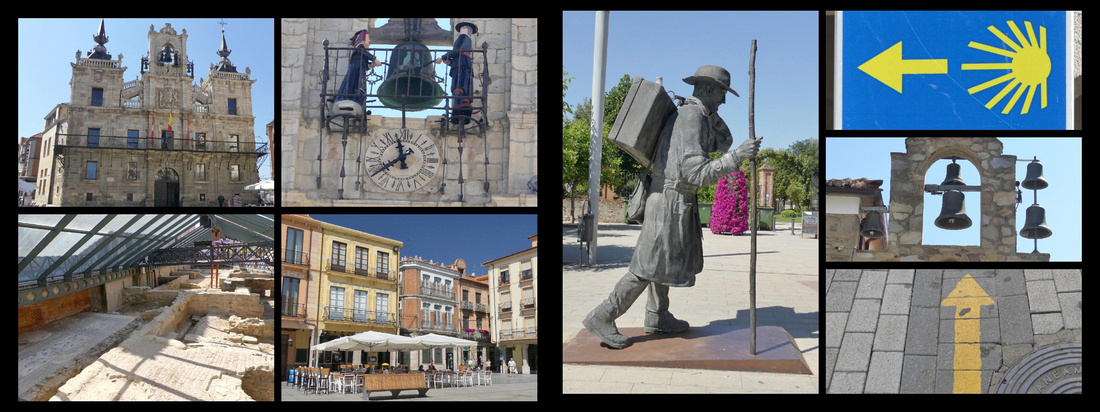

Ponferrada Camino Frances
Easy 45 minute drive out of Astorga, continuing along with the Camino, and into the next town, Ponferrada. Slightly larger (60,000) but signage was still good and directed us to the center where we ran right into an underground parking garage under the town hall plaza. The google maps I had printed out weren’t very good at this point and we weren’t really sure where the castle was but we knew it was close so we parked and started walking around. Geo got to practice his Spanish asking directions. They essentially pointed off to one corner of the Plaza, which fortunately coincided with the signs to the TI, always a good place to start. We walked under a charming old clock tower and then saw the walls of the castle (right next to the TI).
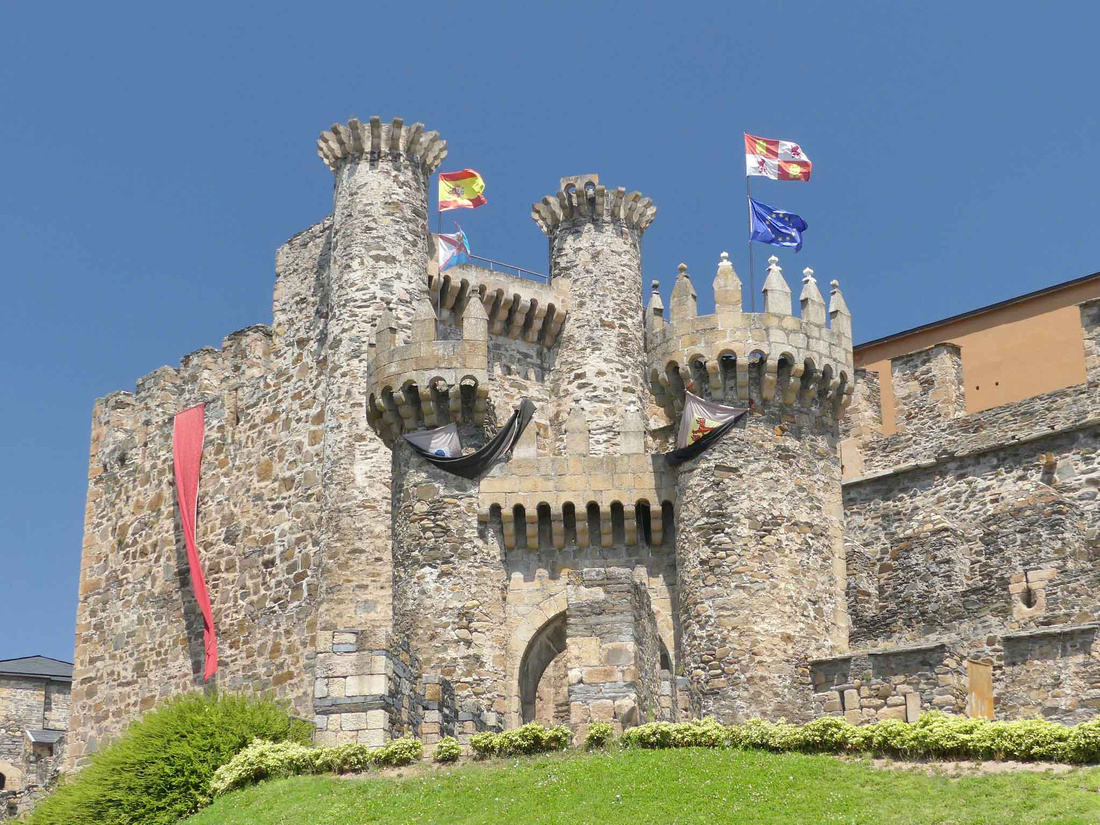

Castillo de los Templarios - has 12th century turrets and battlements that look like gingerbread but were built to protect pilgrims from the very real threat of the Moors by the Knights of Templar, and the arcaded streets and overhanging houses of the old quarter grew up in their protective shadow. The front entrance to the castle is drop-dead gorgeous, exactly what you think a castle is supposed to look like (think fairy tail picture books or Lego castle designs). There are a couple of buildings/towers that have been recently renovated and house a pretty interesting exhibit of medieval life (with English translations) and there are several towers you can climb, but the majority of the grounds are just open areas and there is the ‘old’ castle building, in a slightly crumbling state. Despite it being close to 100 degrees we spent a good hour or so exploring it.


By then it was siesta so the rest of the town had pretty much closed down. Plaza Ayuntamiento is an attractive space in itself (with that similar city hall design). The clock tower, Puerta del Reloj, arches across the street that we walked through to get to the castle is the most interesting building we saw (other than the castle). We got lunch in Plaza Ayuntamiento, retrieved the car and headed on.
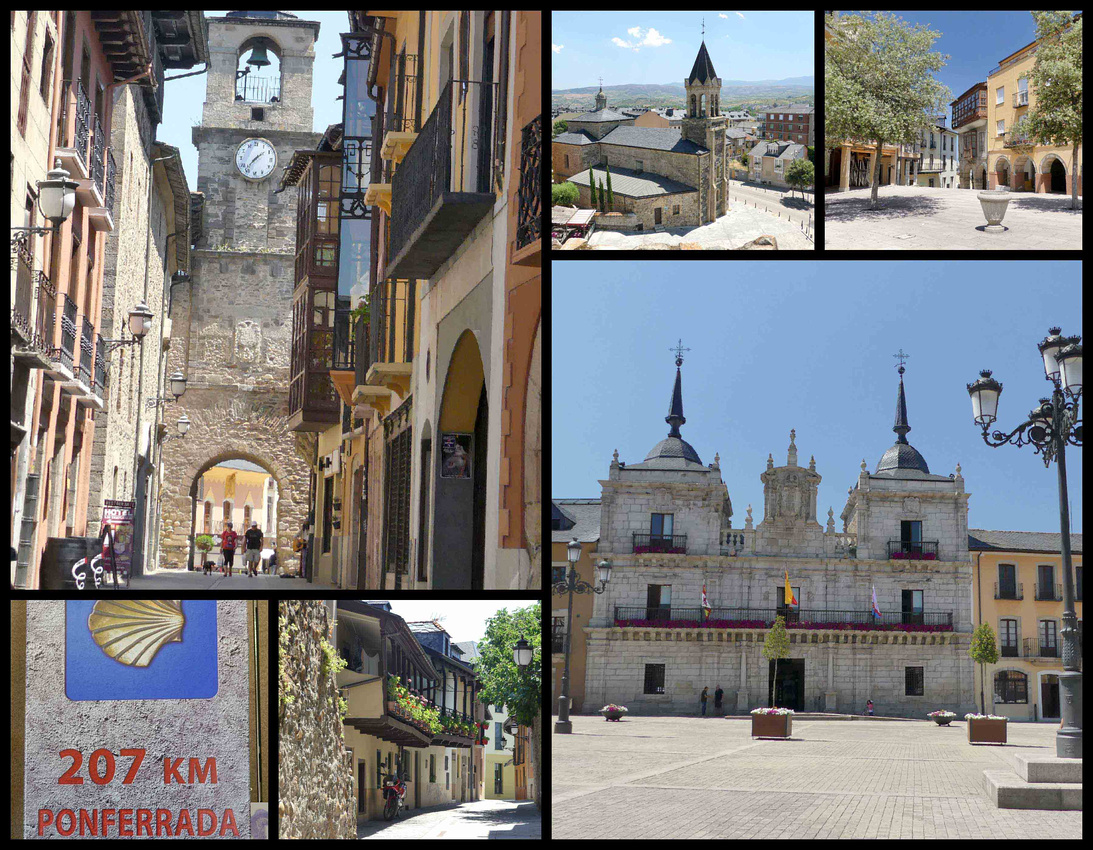

The main road between Ponferrada and Lugo is the A6 highway. And at this point we detoured off the Camino to Lugo (which is on the Camino Primitivo). Leaving the plains behind we entered hilly, green Galicia. Over a period of less than 15 minutes the landscape completely changed.
Lugo [Camino Primitivo] (Roman Walls UNESCO)
Lugo was founded about 14 BC by the Romans, who constructed the Roman wall in the mid 3rd century. After that, the Visigoths were in Lugo until 714 when the town was invaded by the Muslims. Today it’s a small and very pleasant inland provincial capital with a prosperous feel. We wanted to see the Roman Walls, which are a UNESCO world heritage site, and it made perfect one night stop before Santiago.
Driving into the town off the A6 was a breeze and we easily found the Gran Hotel Lugo (which I had chosen because it was a five-minute walk to the walls and town center, yet on a main road and with a parking garage). The hotel is not really our style – it’s large, old and somewhat elegant with a huge shiny lobby – but it turned out to be perfect for our needs. There is a large grocery store across the street where we got ourselves a picnic dinner, and only five minutes to the walls so we were able to go back and forth to the hotel frequently (it was close to 100 degrees and we needed air conditioning breaks).
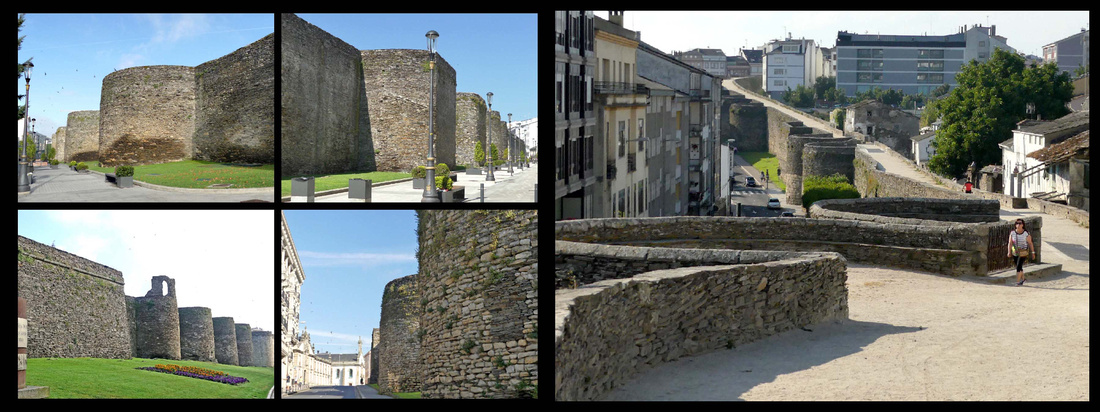

As per UNESCO, the Roman walls of Lugo are, “the finest example of late Roman fortifications in Western Europe.” The circular walls are 10-15 metres high, with 85 circular towers along a circuit of almost 3 km and are broad enough to provide a pleasant thoroughfare for walks around the city. There are 10 gateways to enter the walled area and 6 staircases and a ramp to reach the pedestrian path on top of the walls. Sadly, insensitive building has blocked out most of the views of the surrounding countryside and a busy loop road makes it impossible to appreciate the walls from any distance outside. Walking along the base of the walls is the best way to appreciate their construction and walking along the top of them is the best way to see the town. In the morning much of the walkway on top of the walls is shaded and there are some great views out to the countryside. In the afternoon it’s hot and sunny and in the evening you can see the old town lit up. We walked parts of the walls at all three times and were glad we did.
Within the walls is a beautifully preserved, lively and mainly traffic free historic center. Lugo doesn’t have any ‘great’ sites but it’s a nice place to wander filled with late medieval and 18th century buildings and numerous plazas. The main square, Plaza Mayor, is home to the Ayuntamiento/Town Hall, mid 18th century (clock tower added in the late 19th) which is large and attractive, in Galician baroque, a style that is similar to much Portuguese architecture. The square has nice gardens, shade trees and a bandstand pavilion in the center and is lined with cafes and restaurants.

 top left: Town Hall, right: Plaza Mayor Bottom left: view of the town from the walls Bottom right: Cathedral and around
top left: Town Hall, right: Plaza Mayor Bottom left: view of the town from the walls Bottom right: Cathedral and around
There are numerous shopping streets and plazas within the walls but the most interesting place is Plaza do Campo, a triangle-shaped square. During the Middle Ages, it was the city’s main marketplace. Rúa Nova and Rúa do Miño are the two main streets leading out of Praza do Campo. Just steps from Praza do Campo are the Cathedral and Bishop’s Palace. The cathedral was built over centuries beginning in the 12th and so is of several styles including Romanesque, Gothic, and Baroque; the back and side are more interesting than the front. Across a small plaza is another beautiful building, the Episcopal Palace, 18th century.
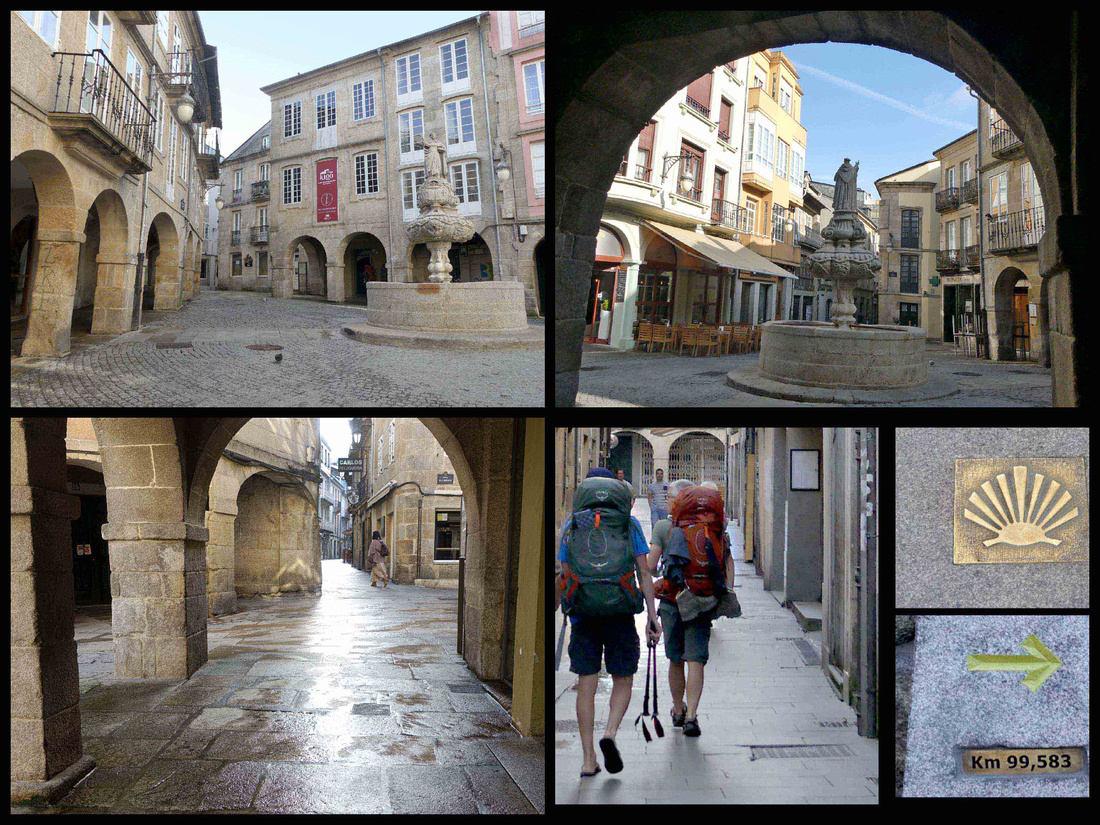

Plaza do Campo
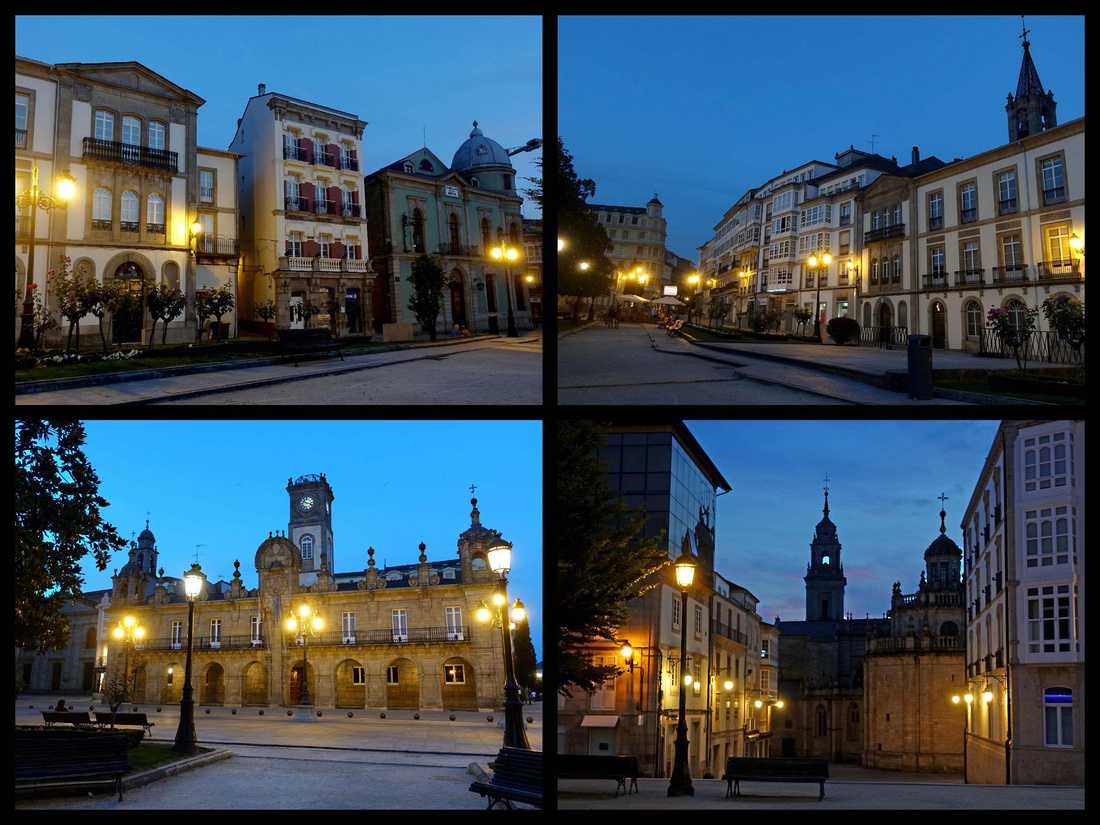

Santiago de Compostela Camino de Santiago
All roads in Spain, at least in northern Spain, lead to Santiago.
Being the end point of the Camino de Santiago makes it the third-most-holy city of the Christian world (after Rome and Jerusalem). But it’s also a university town and a marketplace for Galician farmers. It has cobblestone arcaded streets, beautiful gold/grey churches and buildings and numerous plazas. It is one of the most interesting and historic of Spain's great cities. The medieval city center has been declared in its entirety to be a UNESCO site. The Camino de Santiago (combined routes) is also on the UNESCO World Heritage list.


Although a relatively small size, population 95,000 - 15 minutes walk from one side of the pedestrianized center to the other, it is quite confusing until you figure out your way around and you can walk in circles trying to find your way out. Immediately surrounding the pedestrianized center is a more modern shopping district and a lot of one-way streets. Neither logic nor signage are strong points of Santiago.
Santiago also has the dubious distinction of being the rainiest city in Spain, though the showers are frequent but brief and often consist of just a lot of mist. Water glistens on the facades and vegetation sprouts everywhere with the cathedral coated in orange and yellow mosses and grass poking up from the walls and cobbles.
Rúa do Vilar and Rúa Nova are the two main streets in the old town and they are bounded on either side by soportales or arched, covered walkways. Most of the other streets wind in and around the many tiny plazas.
Just down the street from the cathedral along Rúa do Vilar is the Casa do Deán, the modern-day Pilgrims’ Office where people go to get their compostela or certificate that says they have completed the Camino de Santiago.
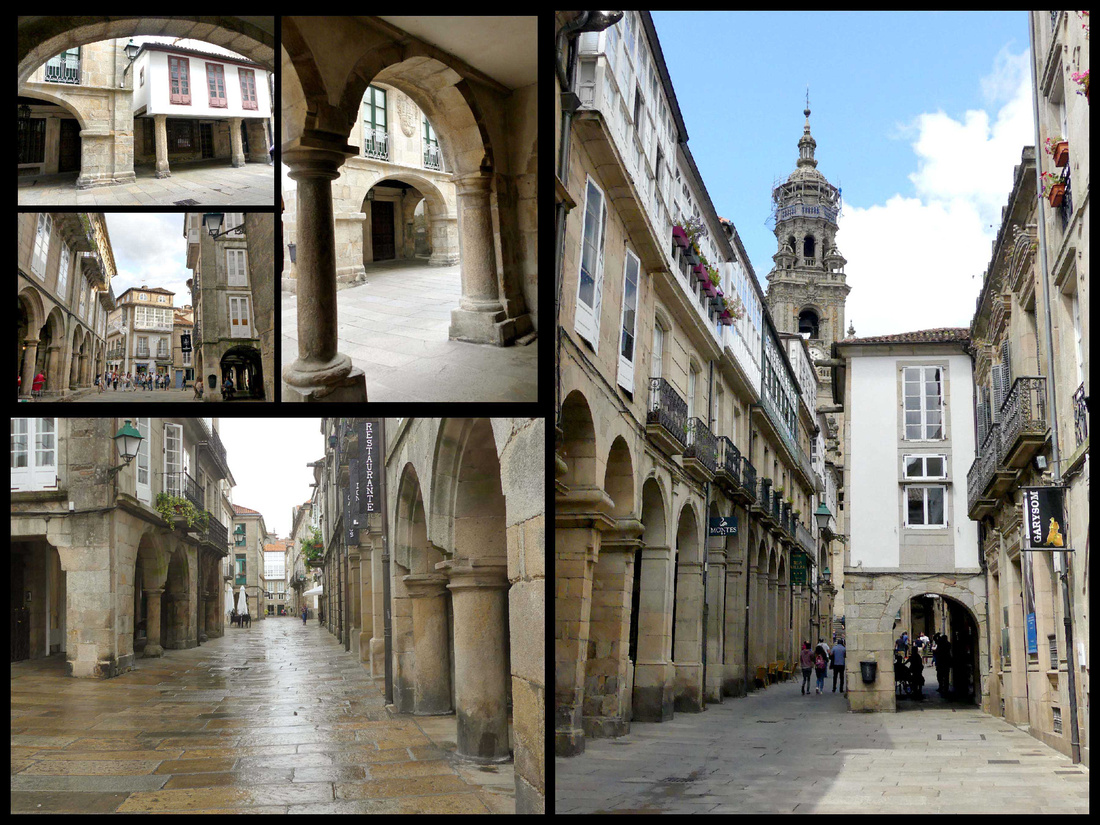

The main thing in town is of course the cathedral, which is sprawling rather than just massive (inside it actually felt quite small compared to Burgos or Leon cathedrals) and has four distinct sides each with a plaza that is lined on its non-cathedral sides with other beautiful buildings.
Plaza do Obradoiro is the ‘main’ plaza facing the ‘front’ of the cathedral – the west side. It has a tile with a scallop shell in the middle of the square that is the official end of the Camino. When it’s not raining the square is full of pilgrims who traditionally sit or lie down here to mark the end of their journey. This square has four different architectural styles: the Cathedral front is 18th century Baroque, the Hostal (now the Parador) is 16th century Plateresque, The city hall is 18th century neoclassical and the university is 15th century Romanesque. This front of the cathedral is featured on Spain’s one-, two-, and five-cent Euro coins. This exuberant façade would be unrecognizable to Pilgrims from the Middle Ages, however, as it completely replaced the earlier one that was designed when the cathedral was built. In the 1700s, a Baroque façade was created, not only to get with the times (the Baroque style was “in” then), but also to finish the work begun a century earlier that had raised the height of the towers; to enclose the Pórtico da Gloria, a medieval sculpture ensemble that had been left to deteriorate in the humid air. As the cathedral (and the city) were built on a bluff between two rivers, a double staircase takes you from the plaza up to “ground level” where the main doors are. Unfortunately it’s been covered in scaffolding for years and still was when we were there.
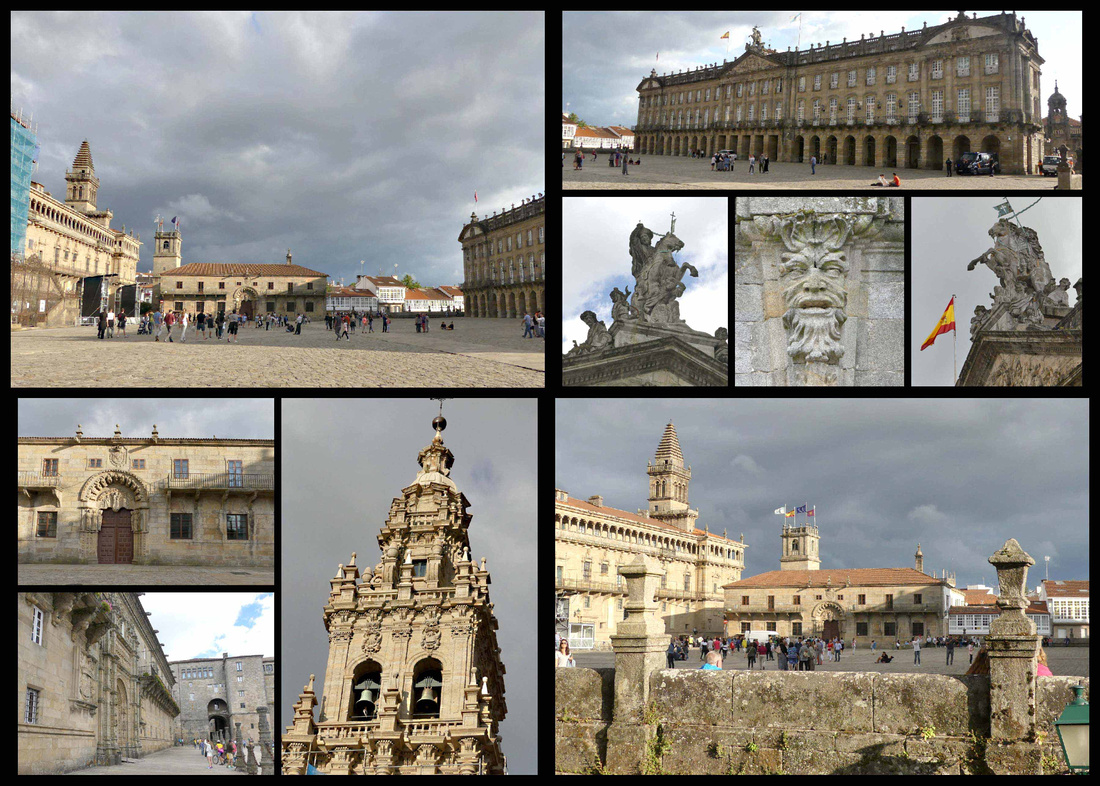
 To the left as you face the cathedral is the massive Hostal de los Reyes Catolicos (Hospital of the catholic kings/ Pilgrims Hospital) an example of Gothic Plateresque architecture. Isabel and Ferdinand came here in 1501 to give thanks for successfully forcing the Moors out of Granada. When they got here they found many sick pilgrims and built the hospital to give them a place to recover. It was free, and remained open until 1952 (when it was still Santiago’s main hospital) when it was converted into a Parador. The hospital later doubled in size in the Baroque era.
To the left as you face the cathedral is the massive Hostal de los Reyes Catolicos (Hospital of the catholic kings/ Pilgrims Hospital) an example of Gothic Plateresque architecture. Isabel and Ferdinand came here in 1501 to give thanks for successfully forcing the Moors out of Granada. When they got here they found many sick pilgrims and built the hospital to give them a place to recover. It was free, and remained open until 1952 (when it was still Santiago’s main hospital) when it was converted into a Parador. The hospital later doubled in size in the Baroque era.
Pazo de Xelmírez/ Colexio de Fonseca, the archbishop’s palace, one of the few remaining examples of civil Romanesque architecture, is where Santiago’s university originated in the 1500s. The front of the building on the square is the original University building, today the library. This is Spain’s 3rd largest university with 30,000 students.
Ayuntamiento /City Hall (Pazo de Raxoi), built in 1766 in Neoclassical style, so pointy Ionic-order columns abound. An arcaded covered walkway spans the entire width of the building—a useful feature in rainy Galicia—and at the top there’s a statue that depicts the legendary Battle in which Santiago rides in from heaven to help the Christians as they fought against the Moors.
Praza das Praterias is the south façade, the church’s oldest and the only Romanesque façade that appears as it did eight centuries ago. A double portal supports carved marble columns, sculpted tympanums, and an upper frieze. The clock tower’s base was built in the 1400s but the upper section was remodeled in the Baroque style in 1680.


Casa do Cabido, the cathedral’s chapter house that was built in 1759 for the sole purpose of beautifying the plaza. This building with pretty red doors and windows is only three meters deep—pure façade. Gotta love the Baroque era!
On the square’s east edge is the Museo das Peregrinacións e de Santiago, a museum with a scale model of the cathedral plus a model of what the walled city of Santiago would have looked like in the Middle Ages.
Praza da Quintana is the square to the east of the cathedral. It is a curious space, with an upper and lower half; these are known as the halves of the living (the top) Praza de Quintana de Vivos, and the dead (below) Praza de Quintana de Mortos; the area used to be a cemetery. The portal on this side is known as the Puerta Santa, or holy door. The façade is 17th century, but contains figures salvaged from the Romanesque stone choir. The 18th -century clock tower soars over both Praza das Praterias and Praza da Quintana. The three walls that zig-zag across the cathedral’s east façade were put together to give a uniform look and feel to this side of the church, since it had become a helter-skelter collection of side-chapels bubbling out from the transept and apse.

 On one side of this square is Casa de la Canónica, the former residence of the canon. Across the square from the cathedral is the Saint Pelayo Monastery (Mosteiro San Paio). Founded a thousand years ago as a monastery to look after St. James’ tomb. Benedictine nuns moved in after their Benedictine brothers moved out in 1499.
On one side of this square is Casa de la Canónica, the former residence of the canon. Across the square from the cathedral is the Saint Pelayo Monastery (Mosteiro San Paio). Founded a thousand years ago as a monastery to look after St. James’ tomb. Benedictine nuns moved in after their Benedictine brothers moved out in 1499.
Praza da Inmaculada (north facade) was the final stop along the Camino for pilgrims hiking the Camino Frances - the "French Way" - and the Camino Ingles - the "English Way" (which starts on the north coast). All medieval pilgrims would have entered the church here at the north door, the Porta do Paraiso (Paradise Portal). The north entrance is also called the Azibecheria facade because shops nearaby sold jewlery made from azibeche, or jet, a black gemstone. Today the Caminos all technically end in the Plaza do Obradoiro.
Facing the Azibechería entrance looms the huge former monastery of San Martiño Pinario, once the second-largest monastery in all of Spain. Today it houses the Seminario Mayor (seminary for Catholic priests) and an hospedería for pilgrims.


